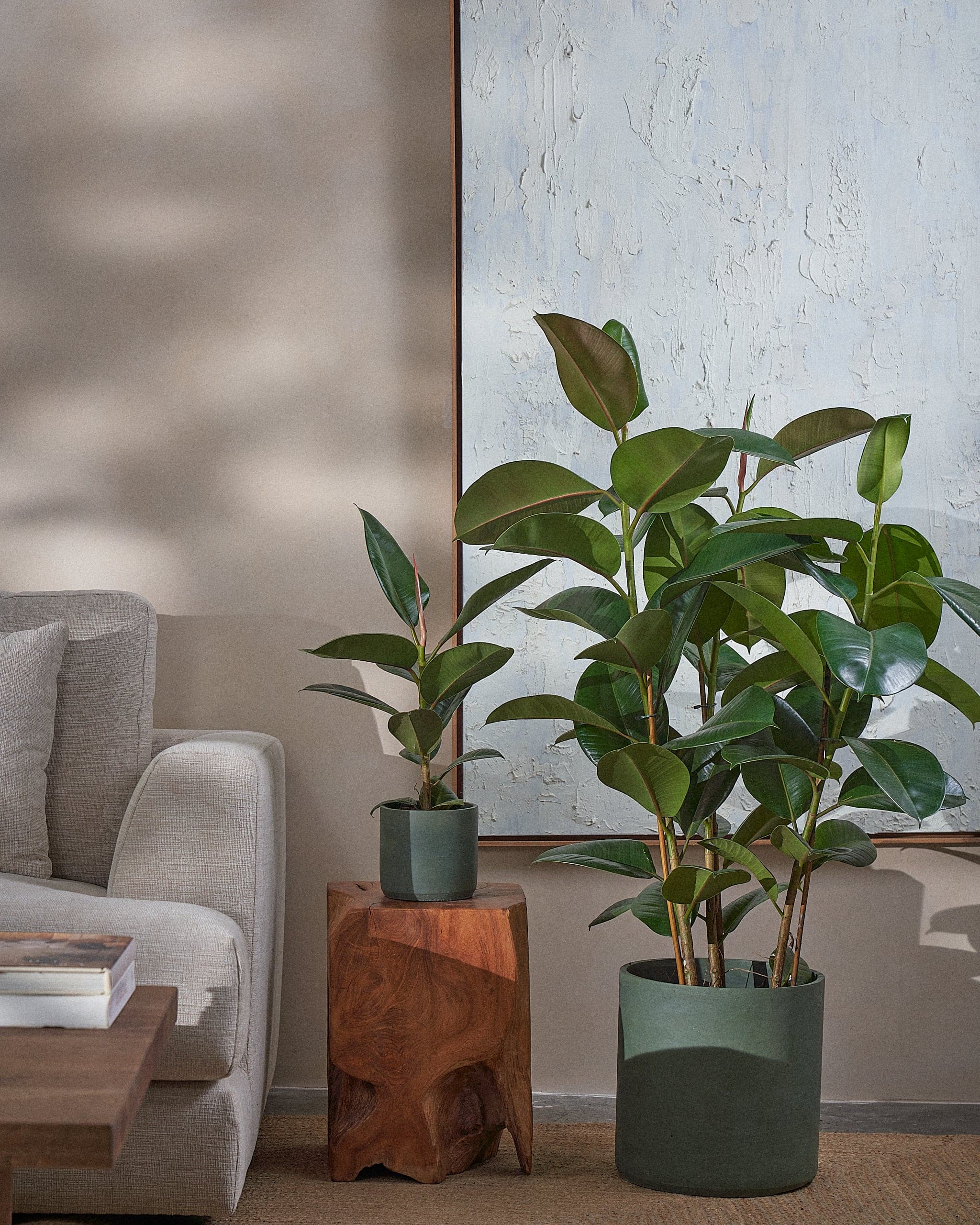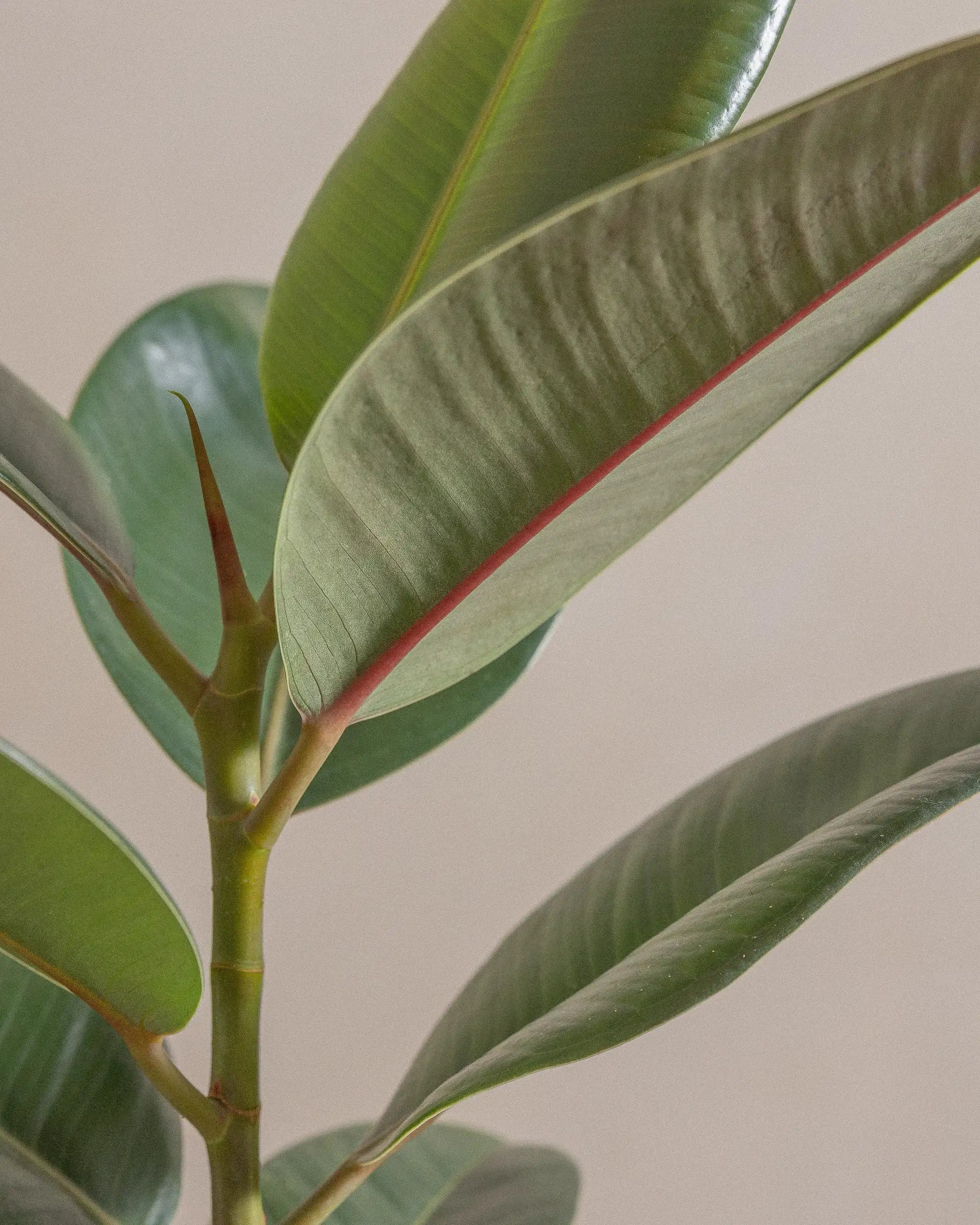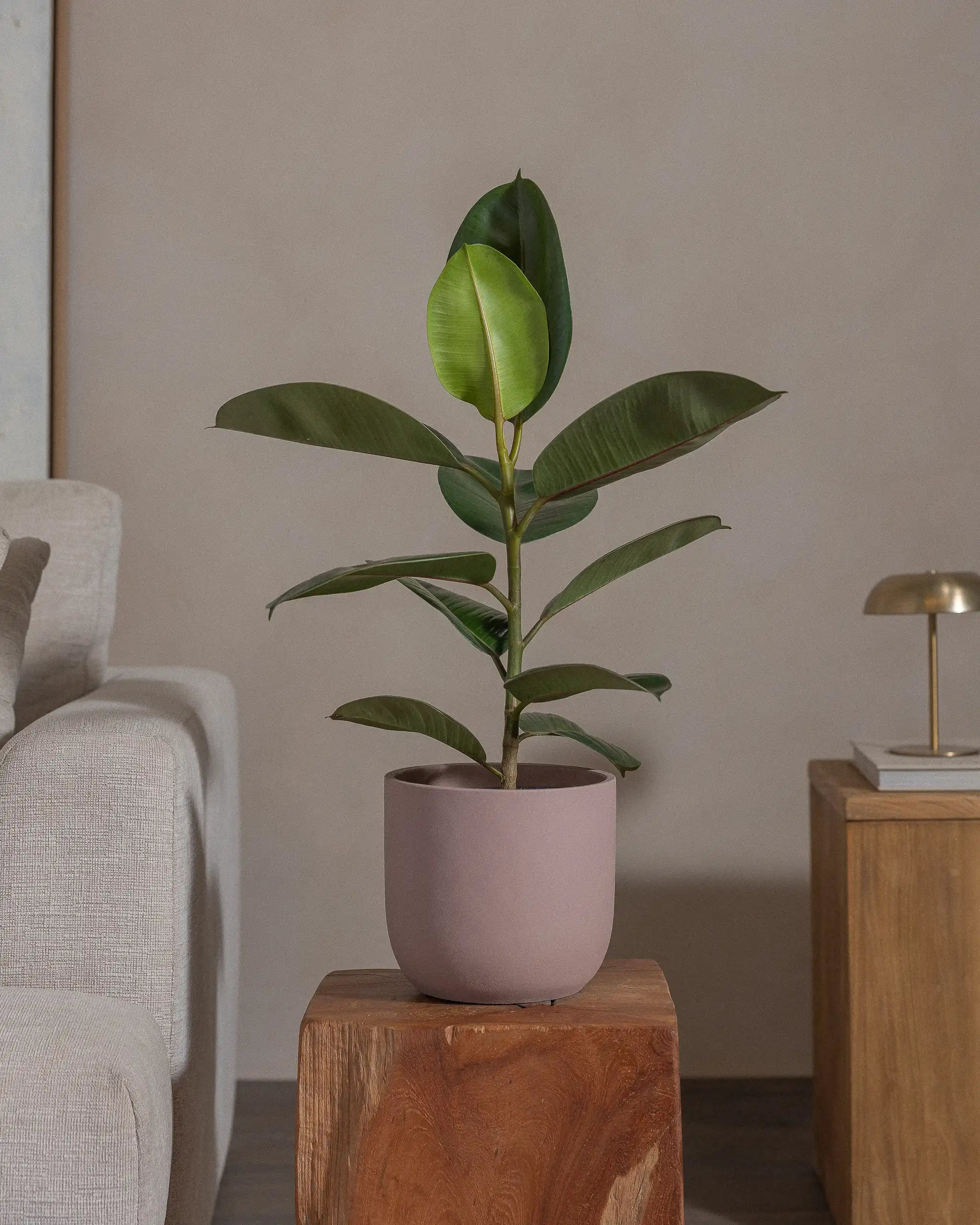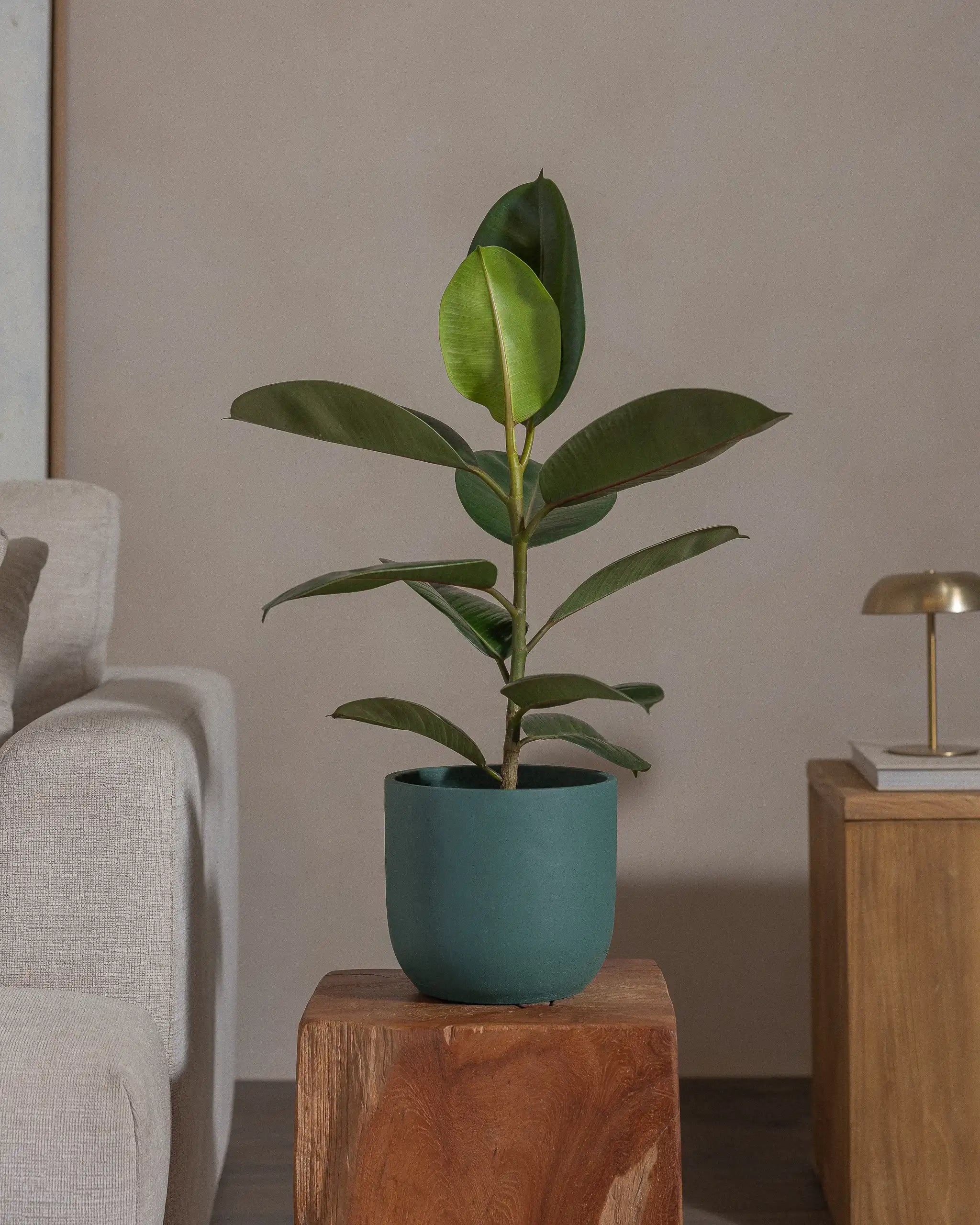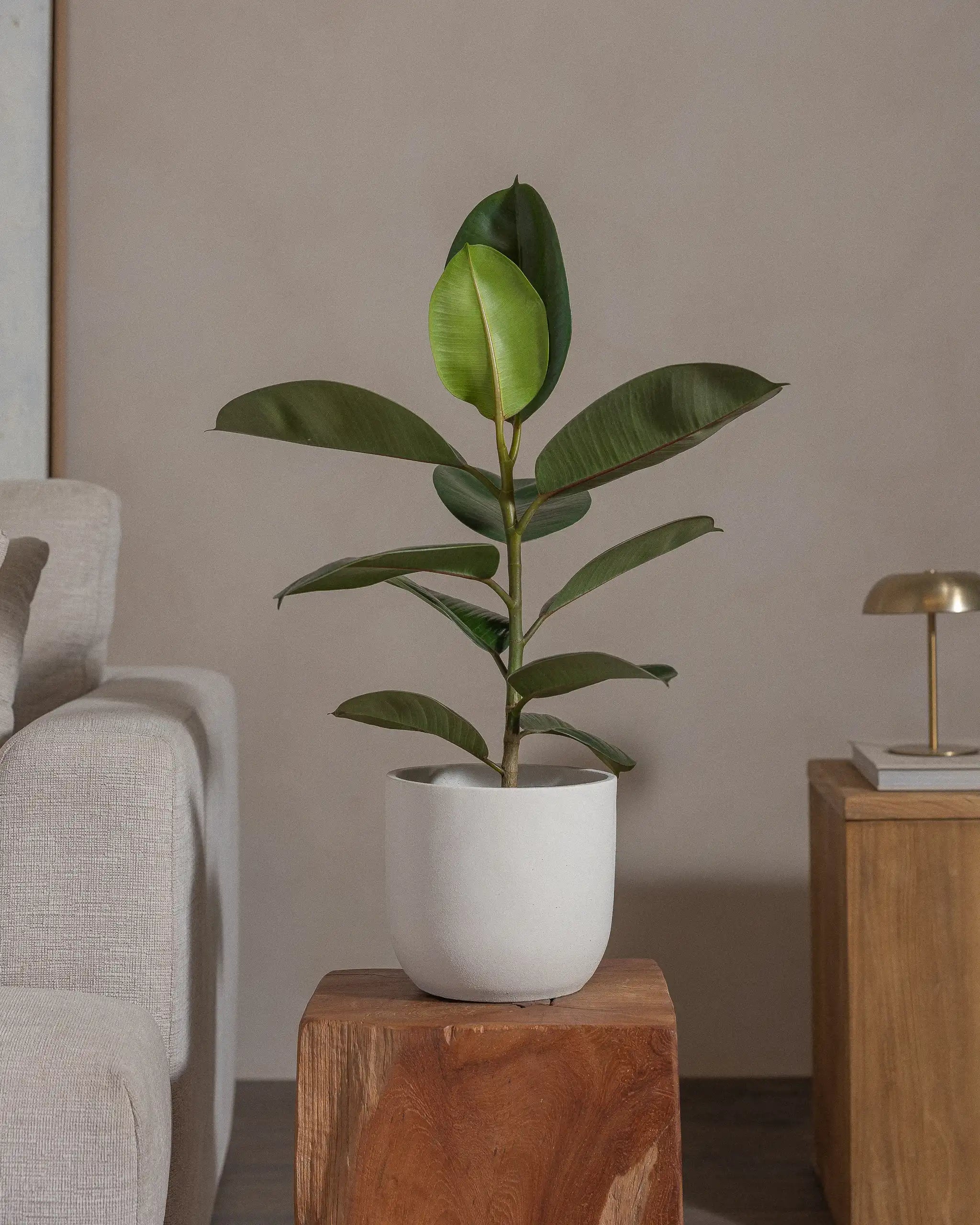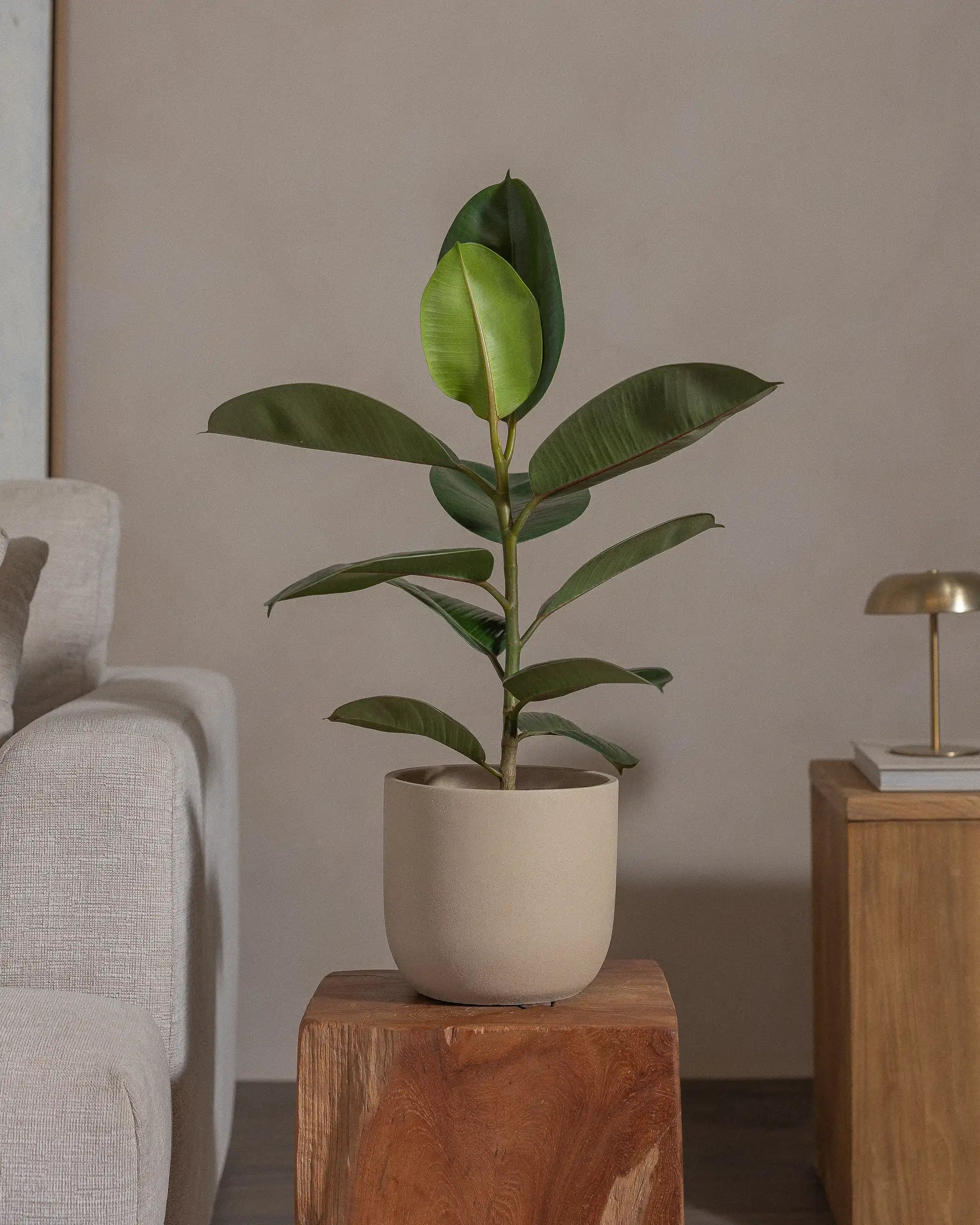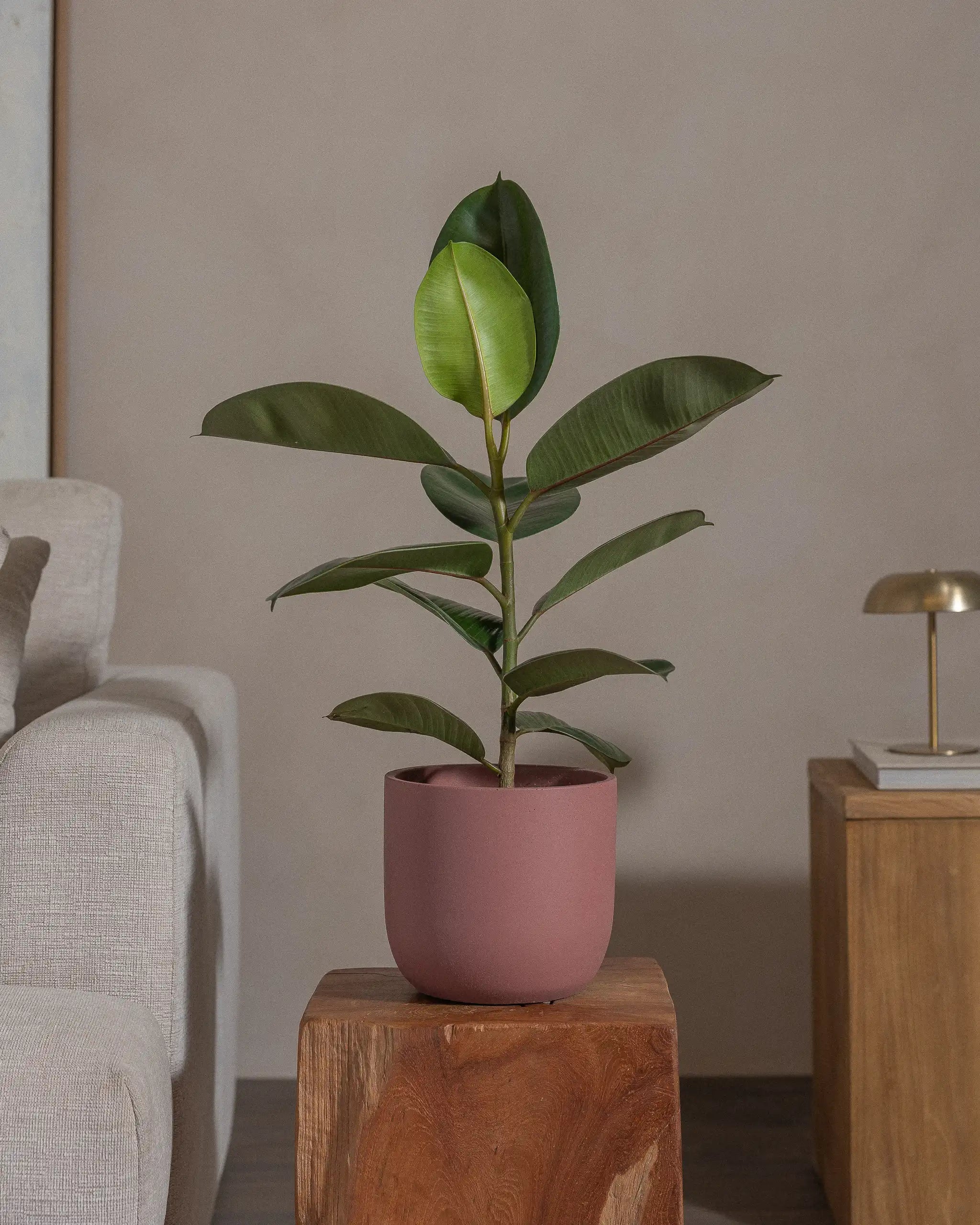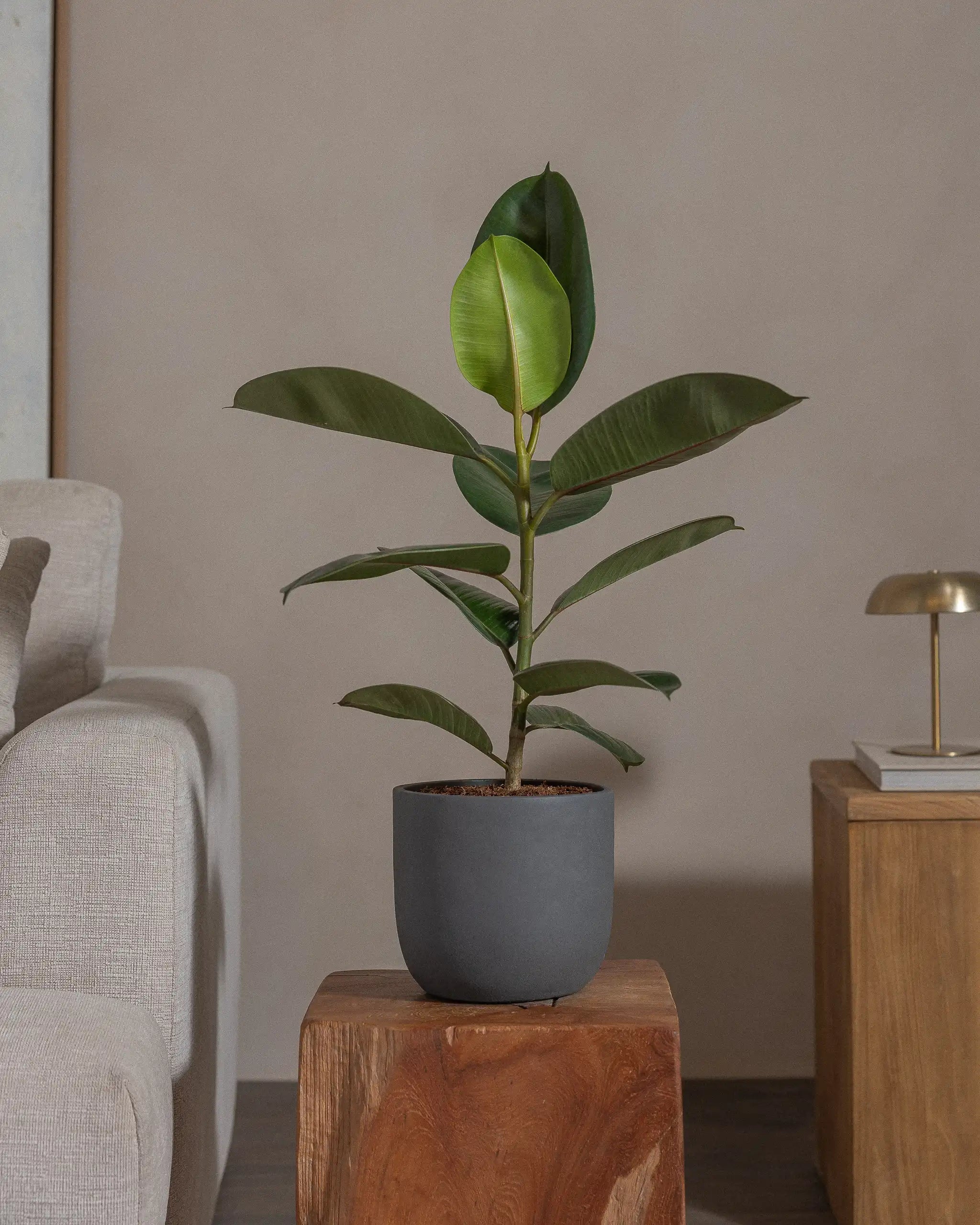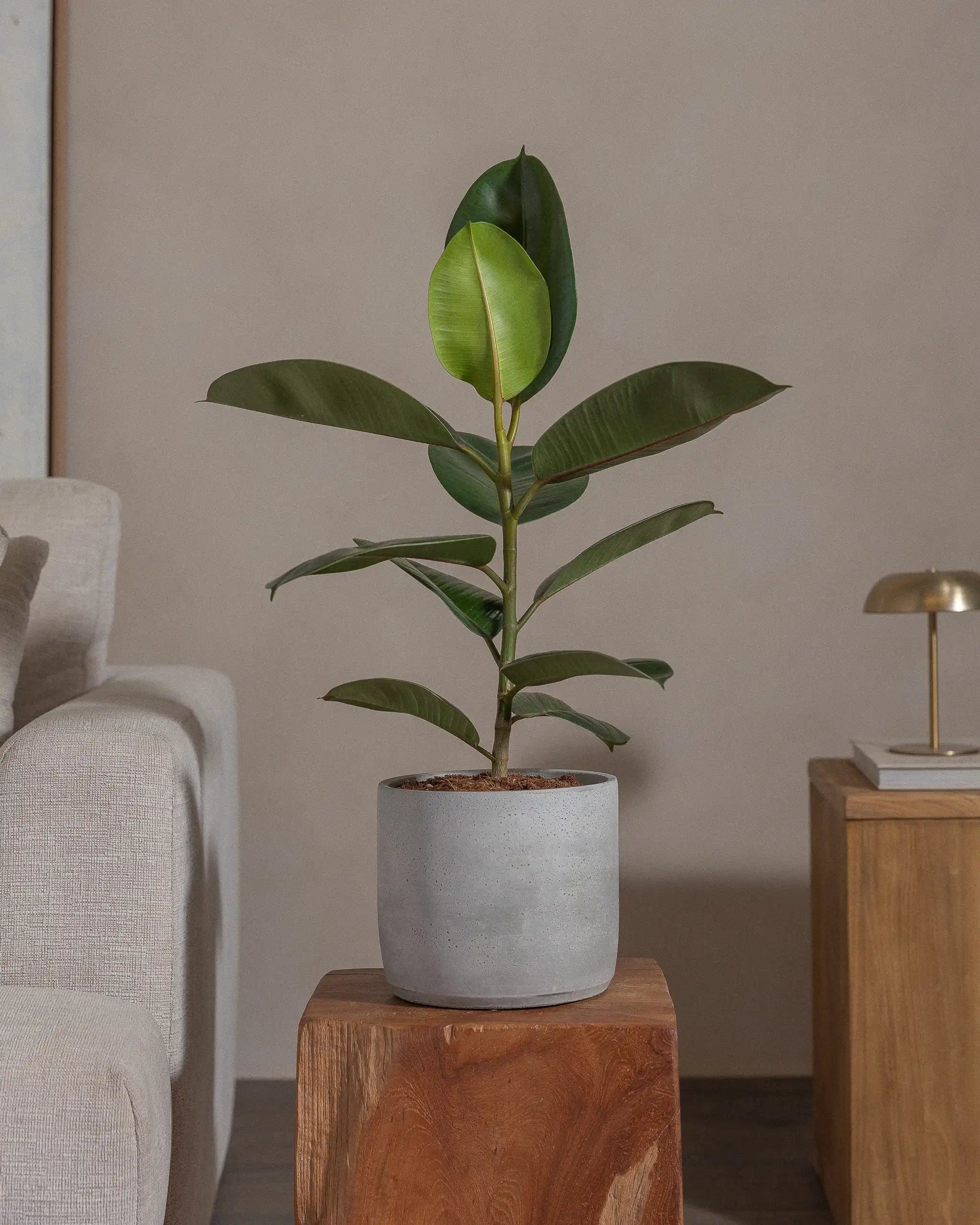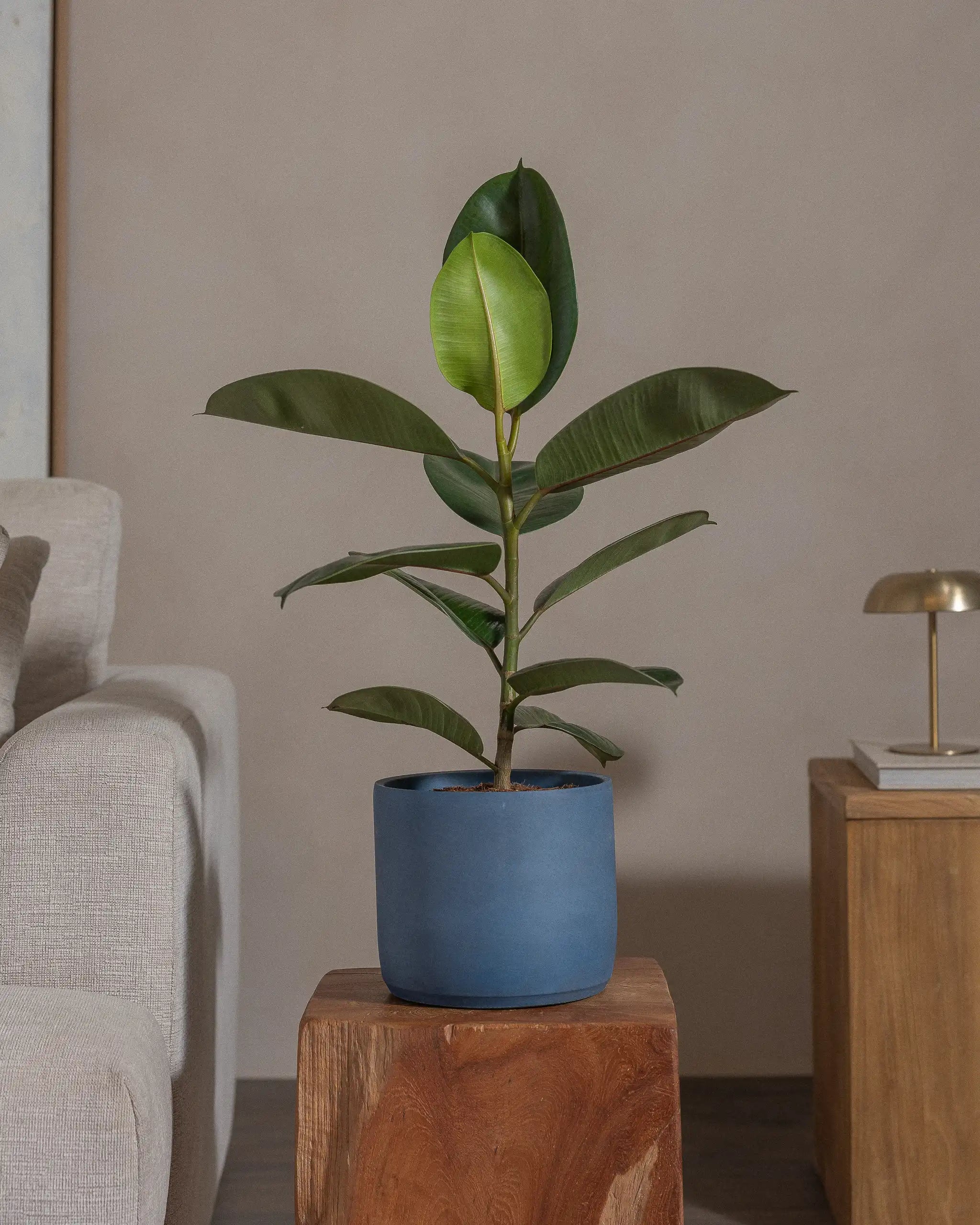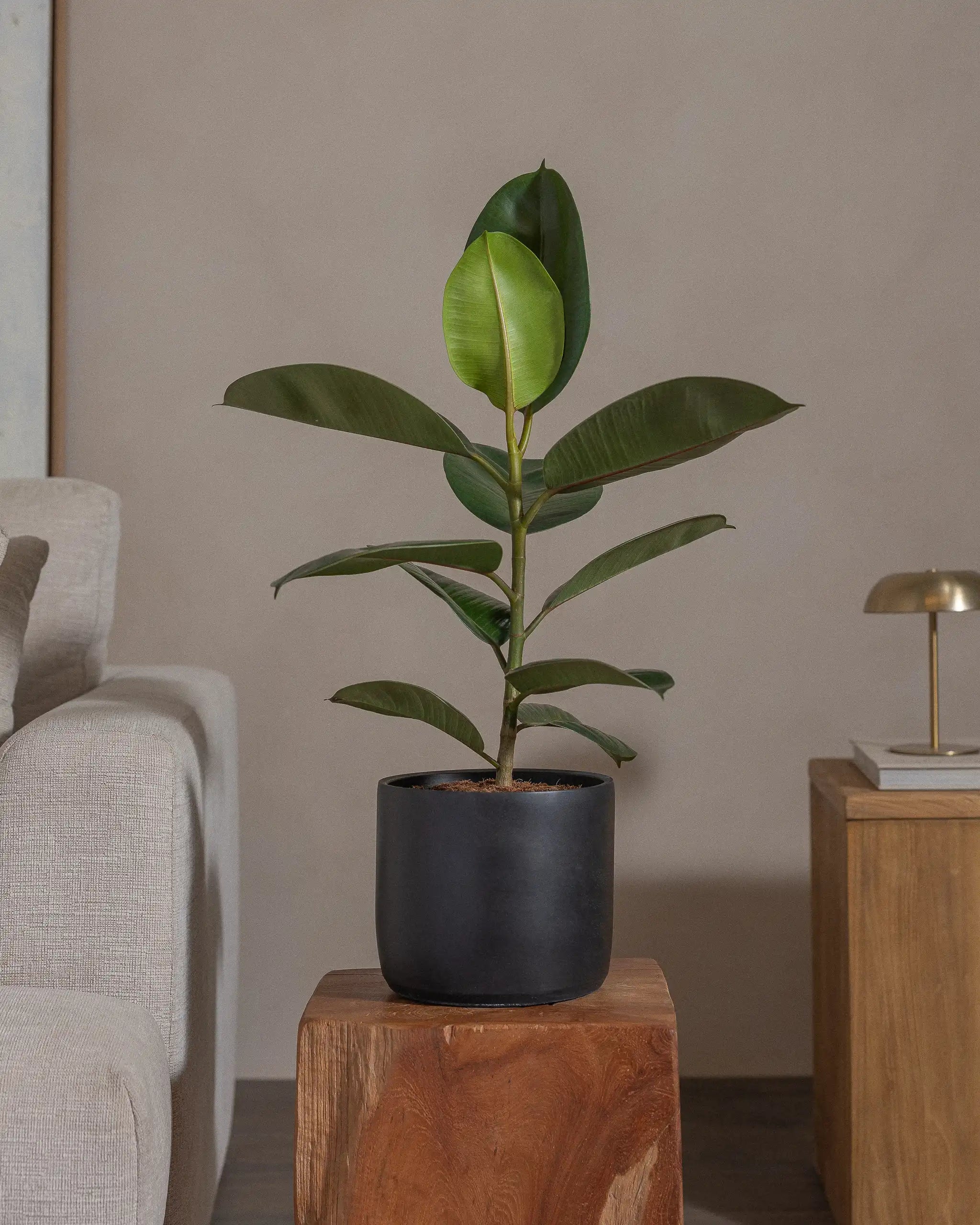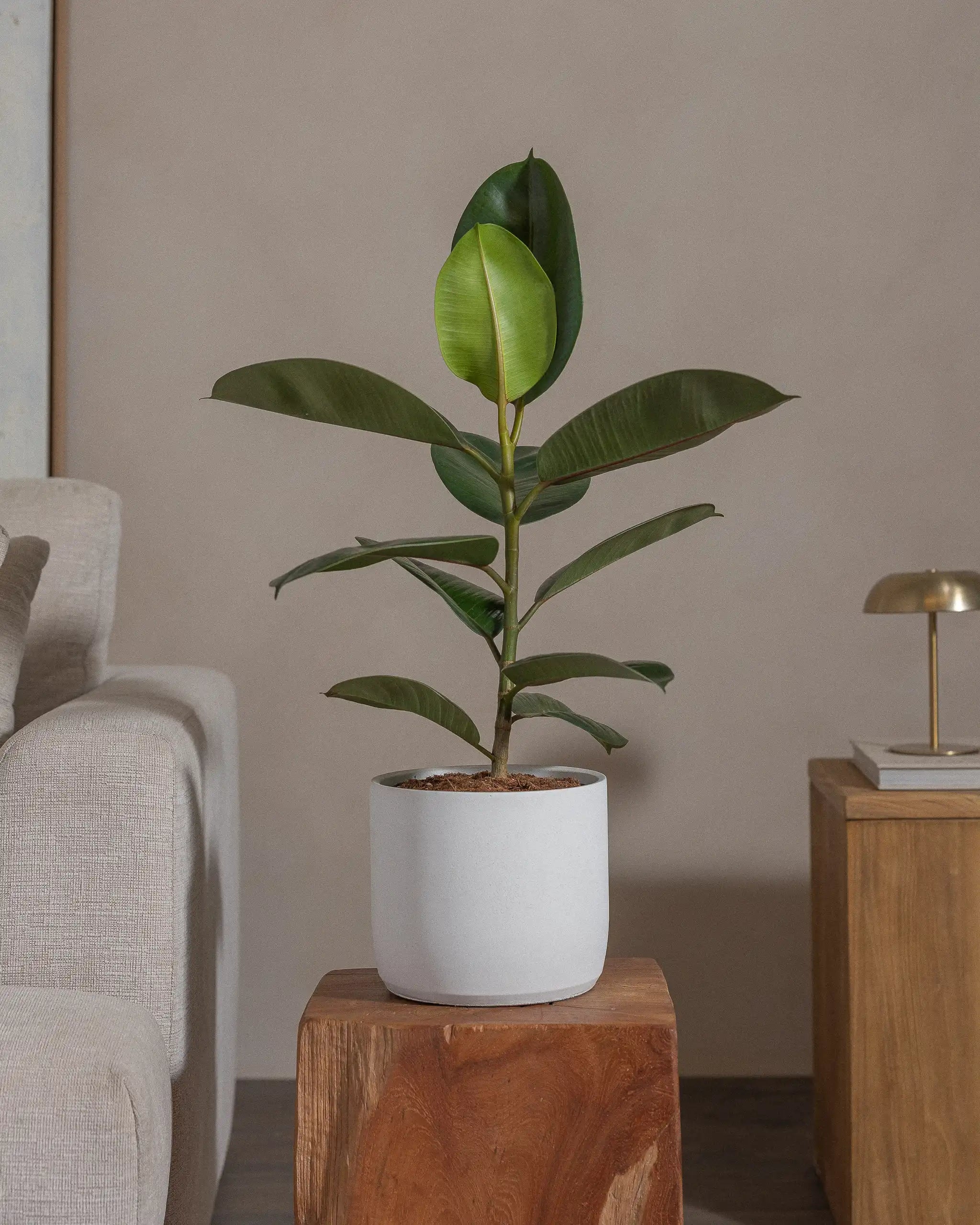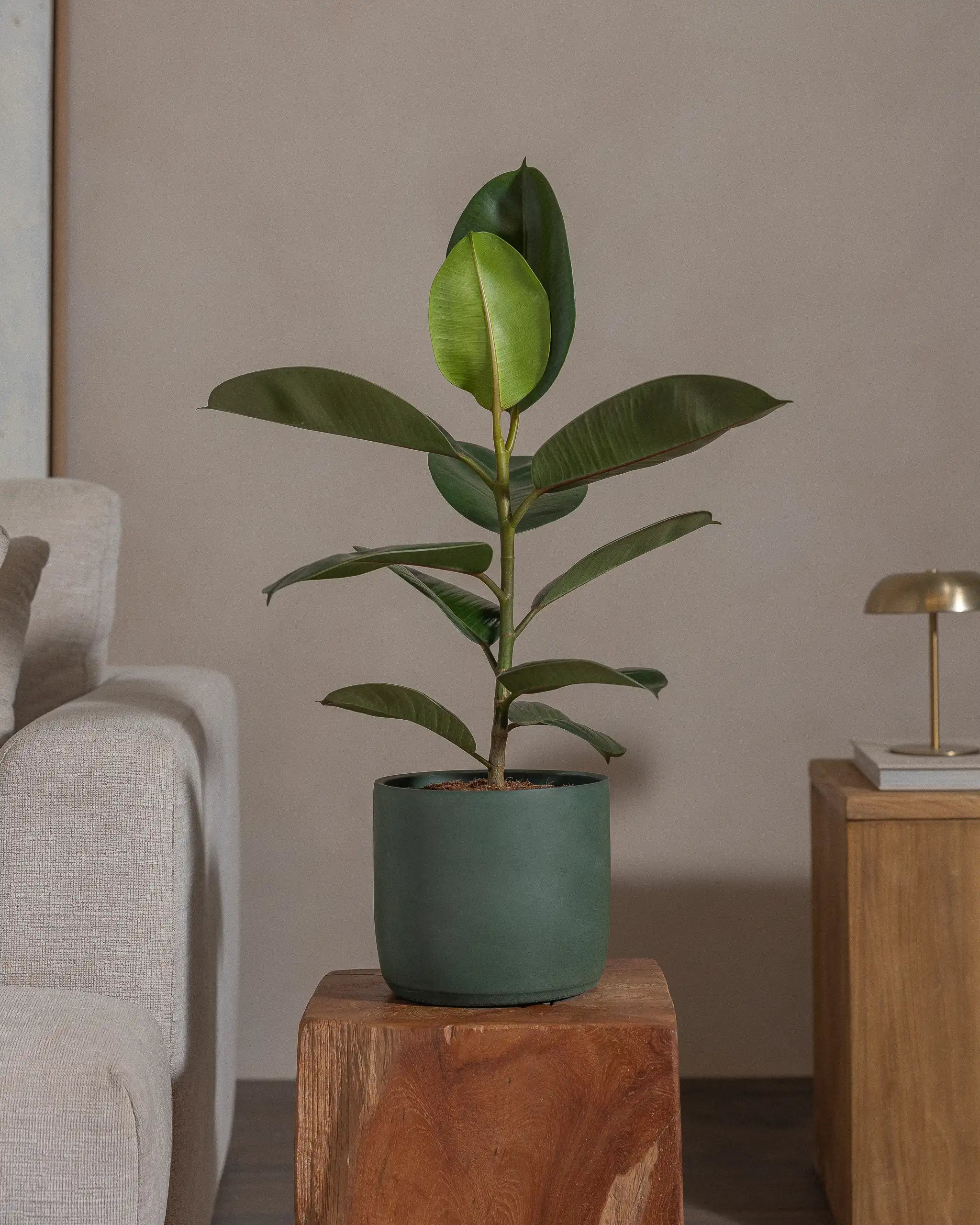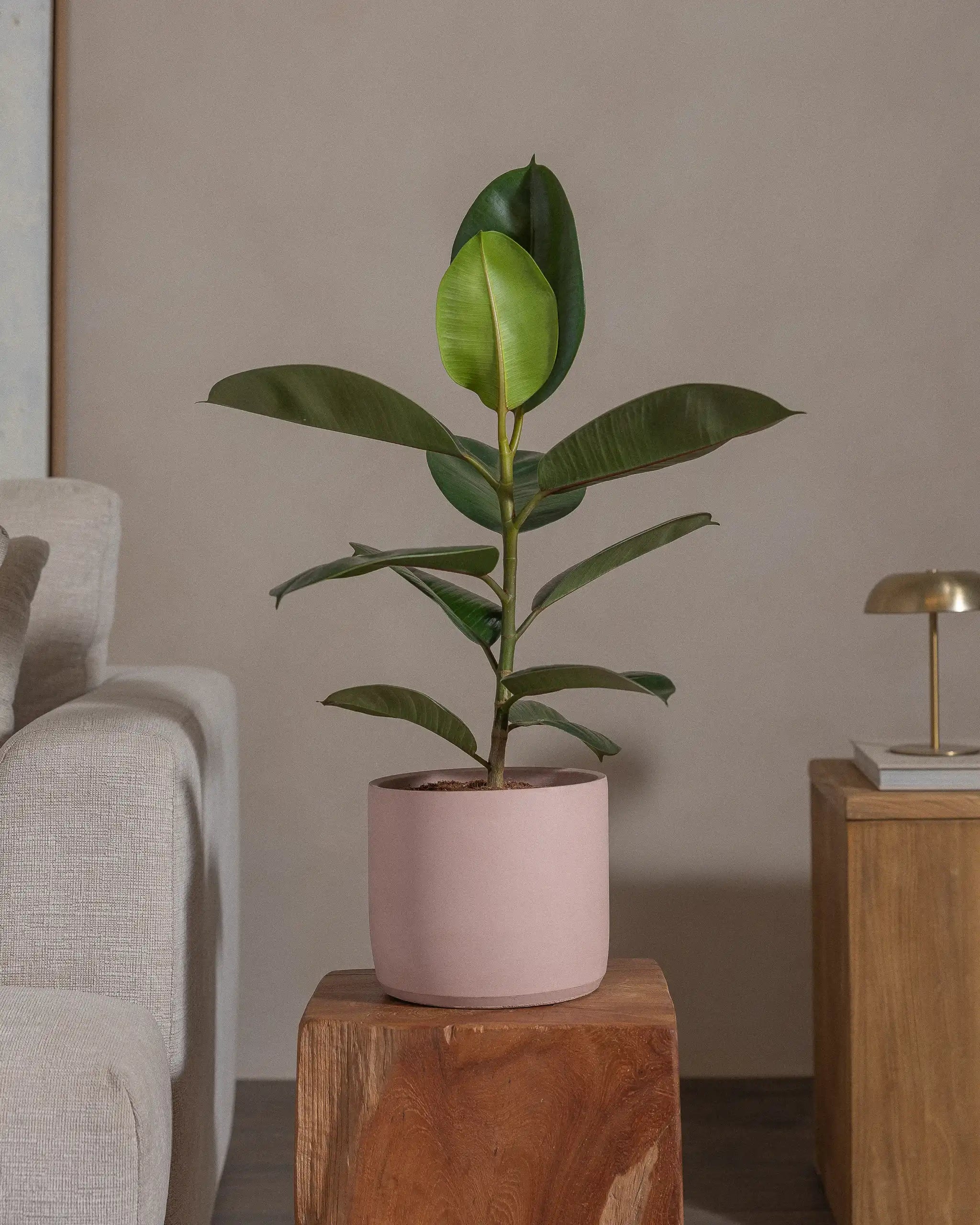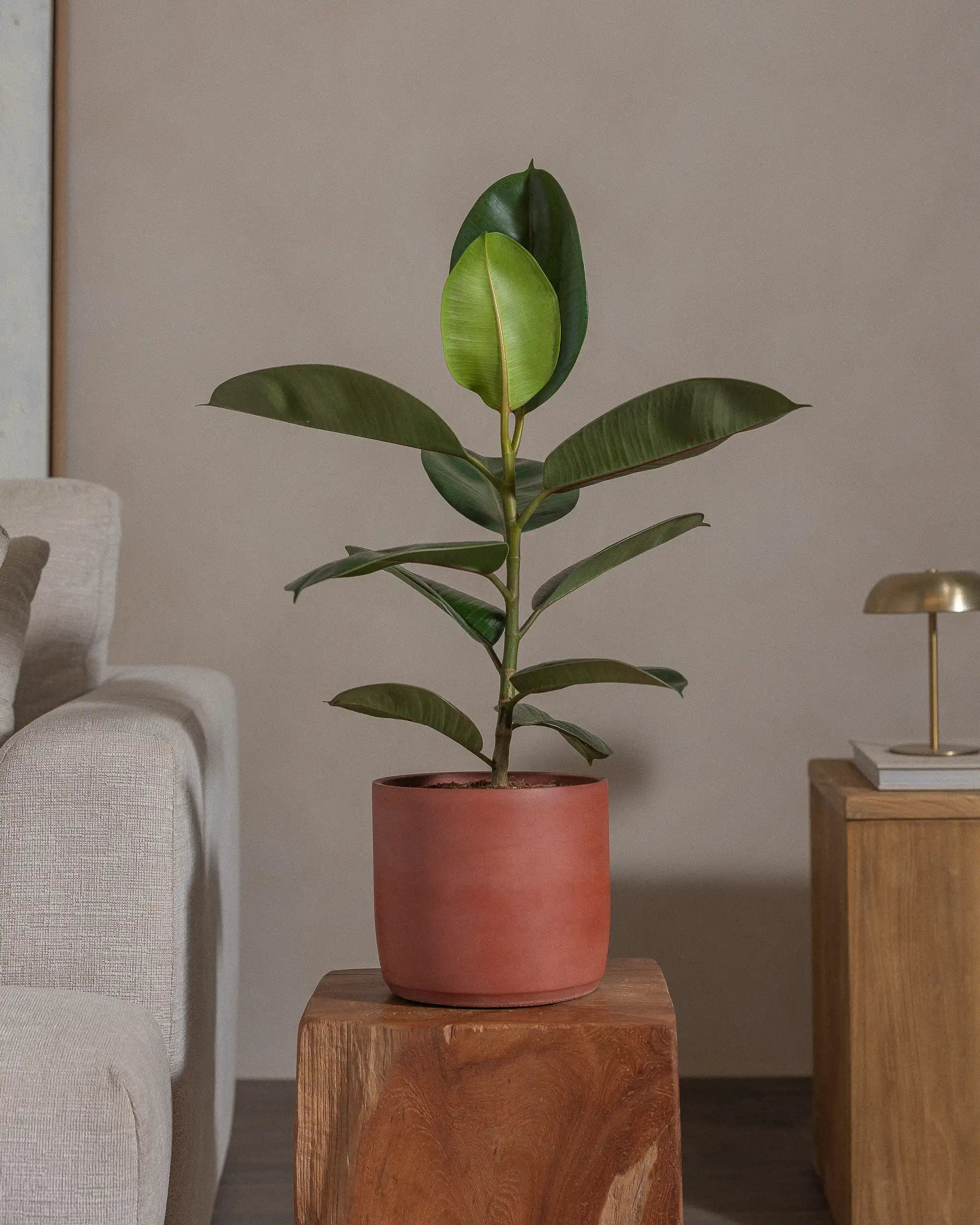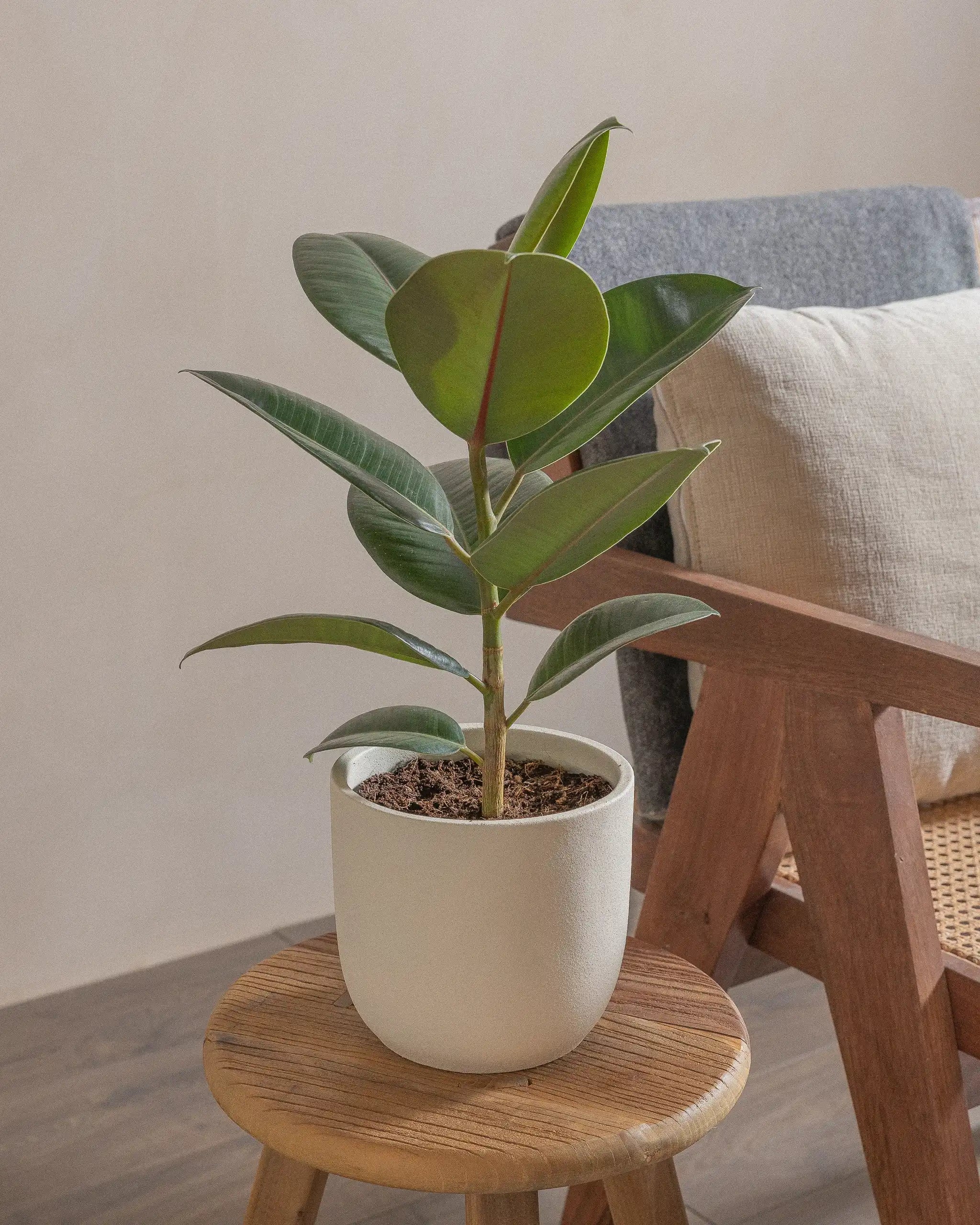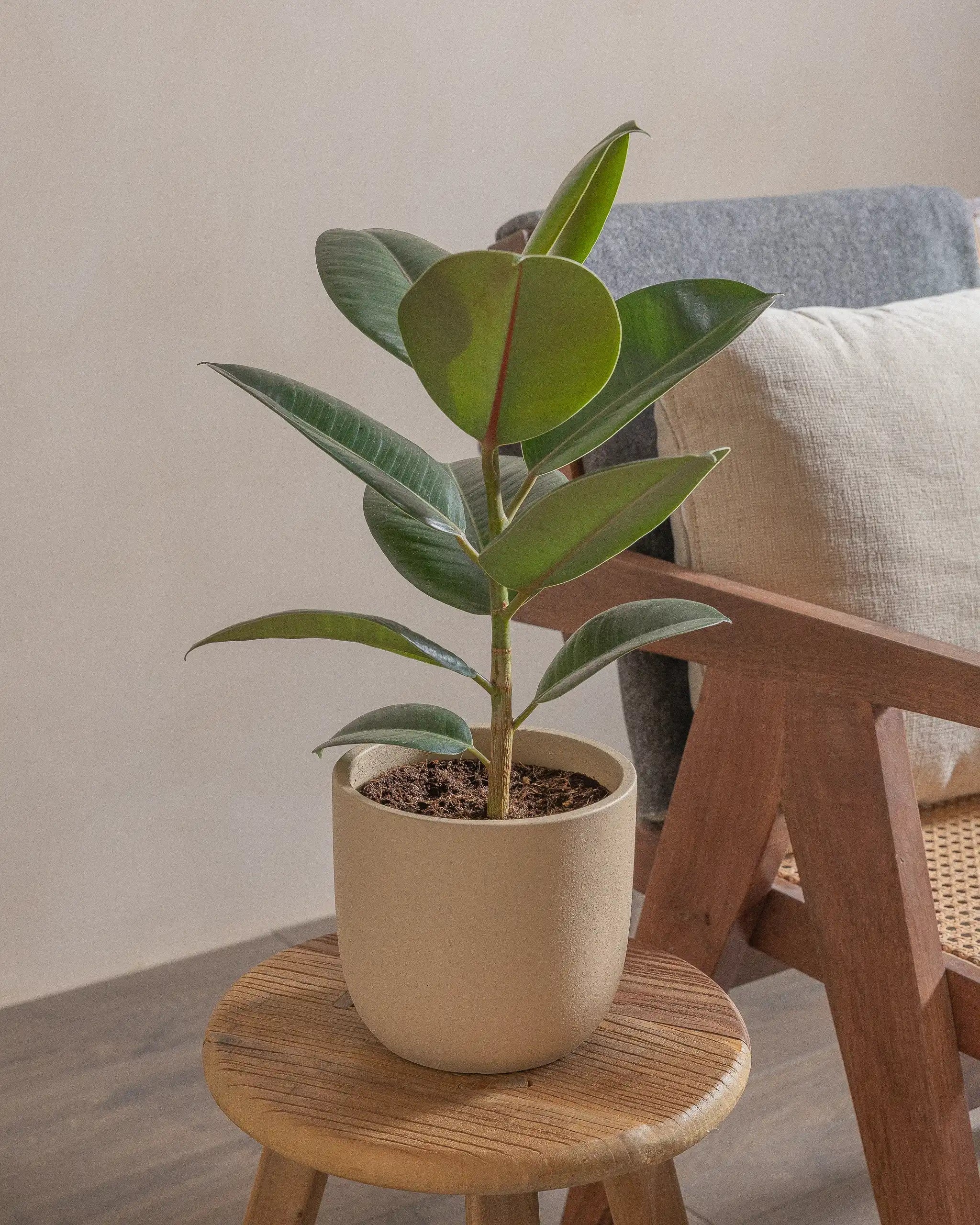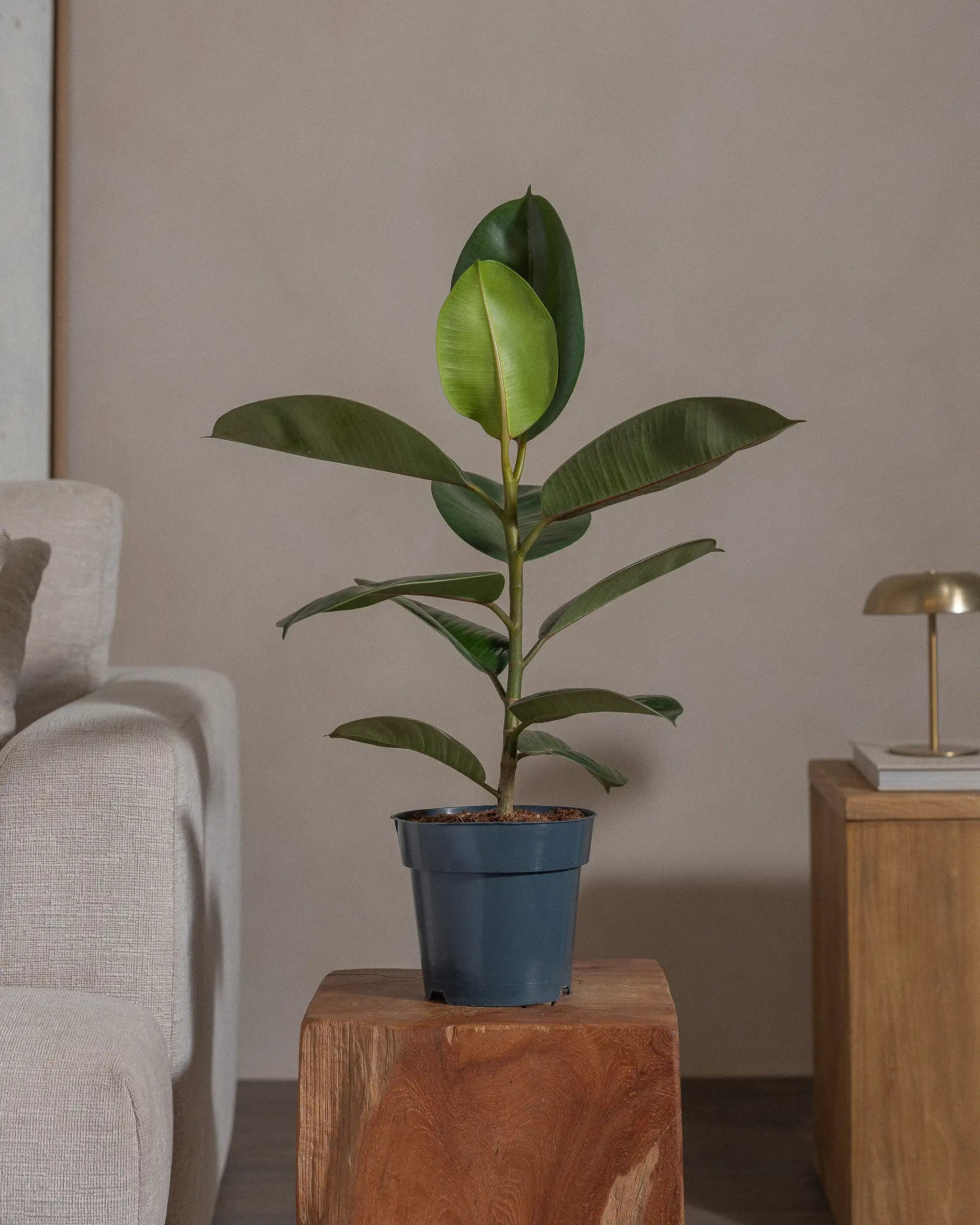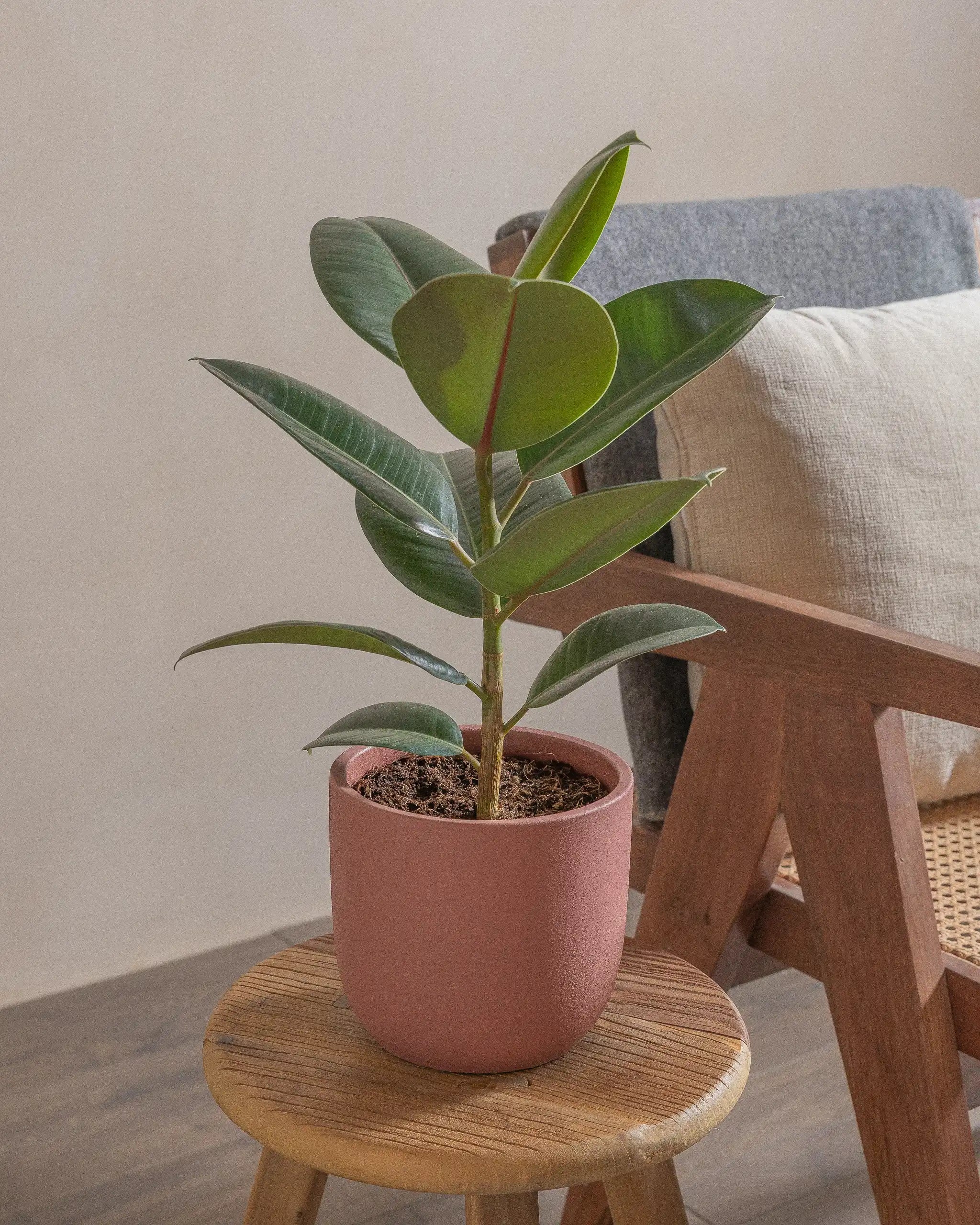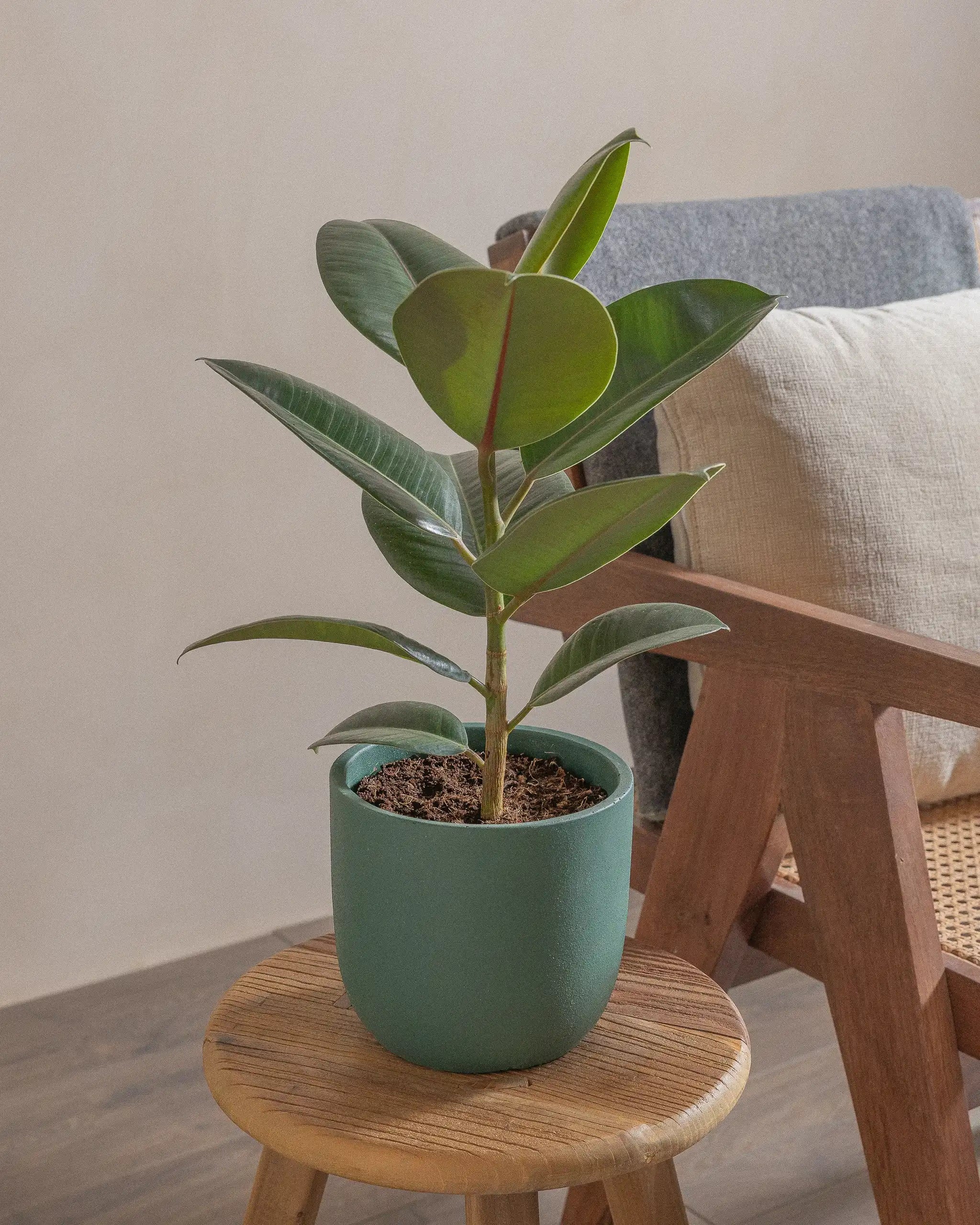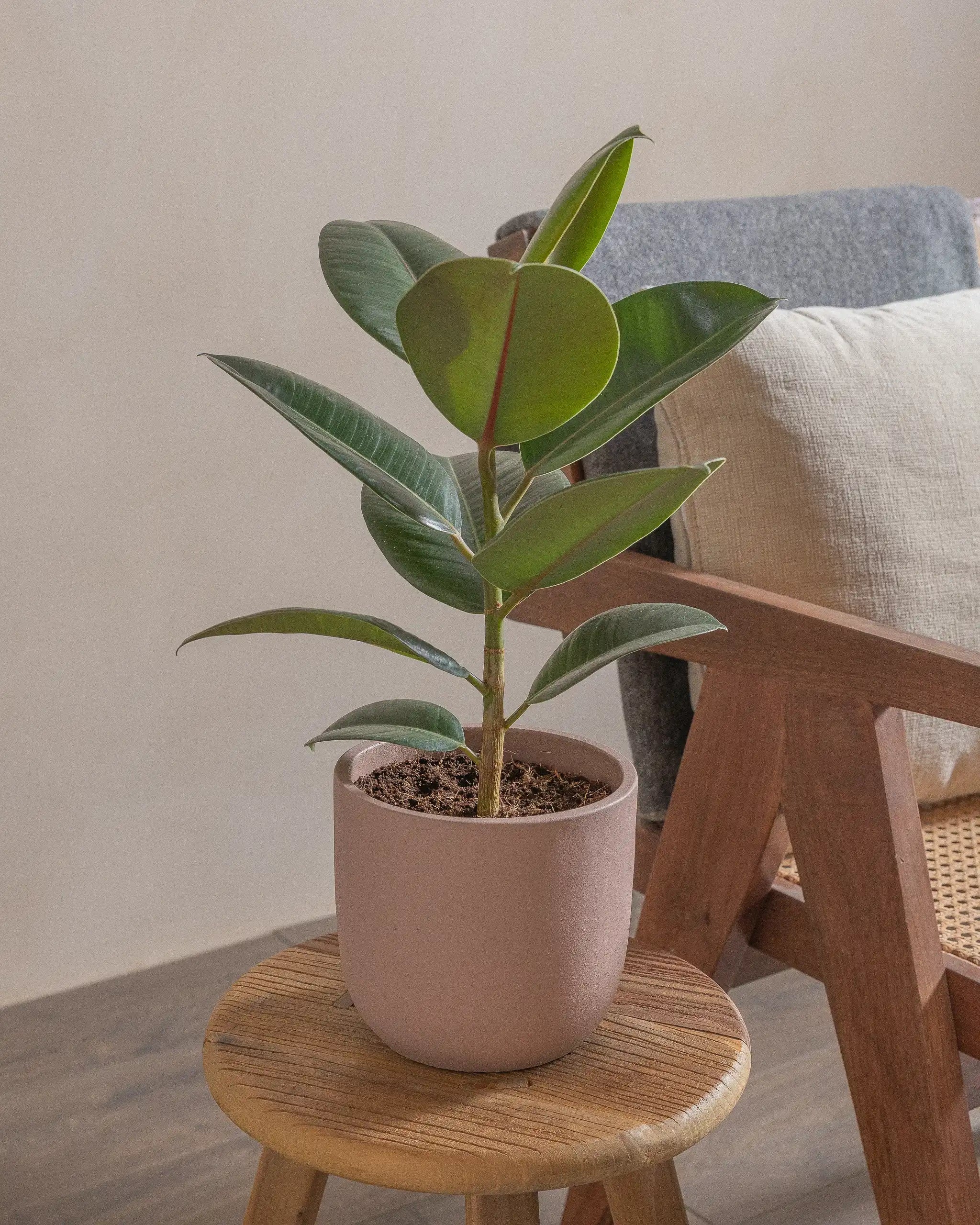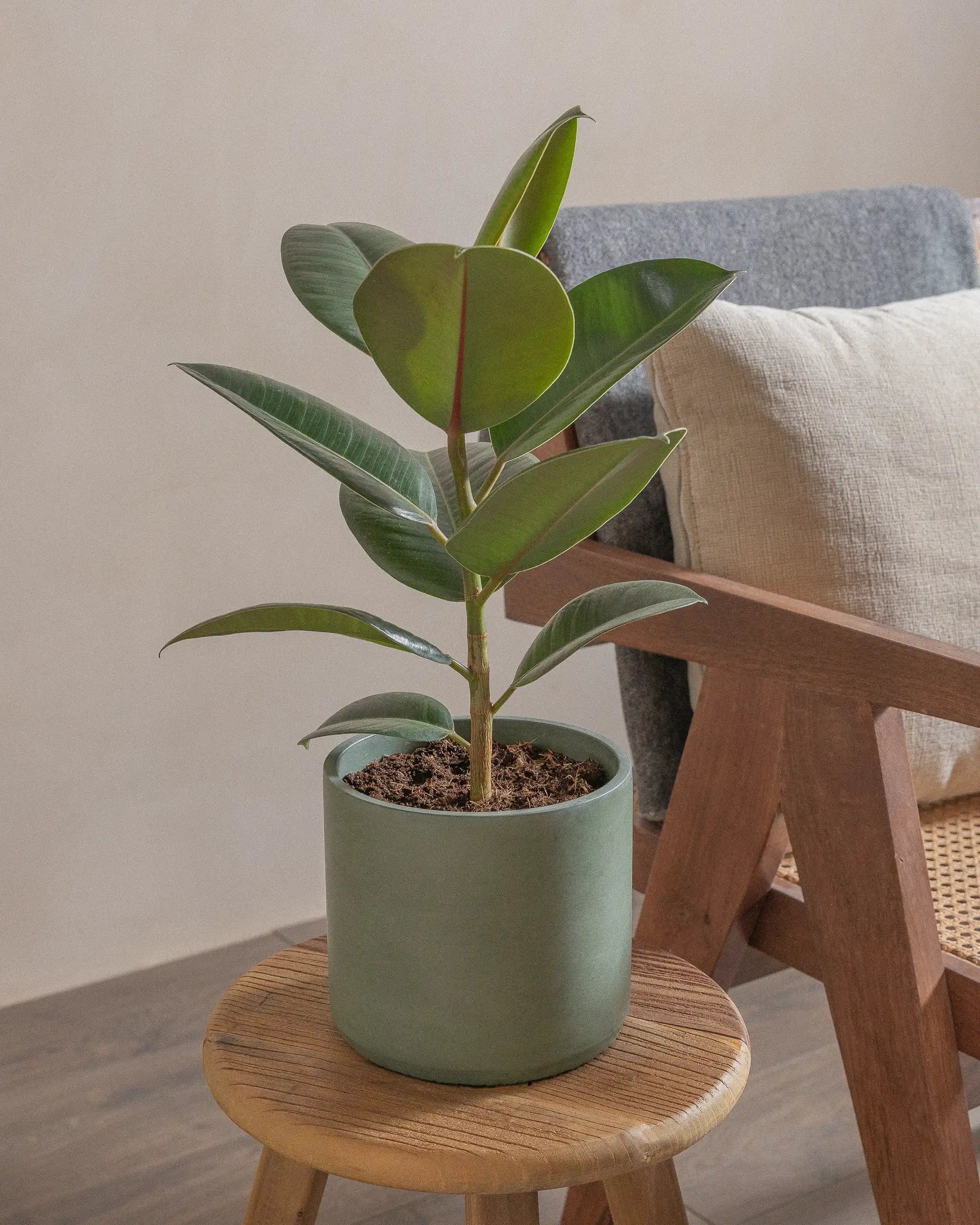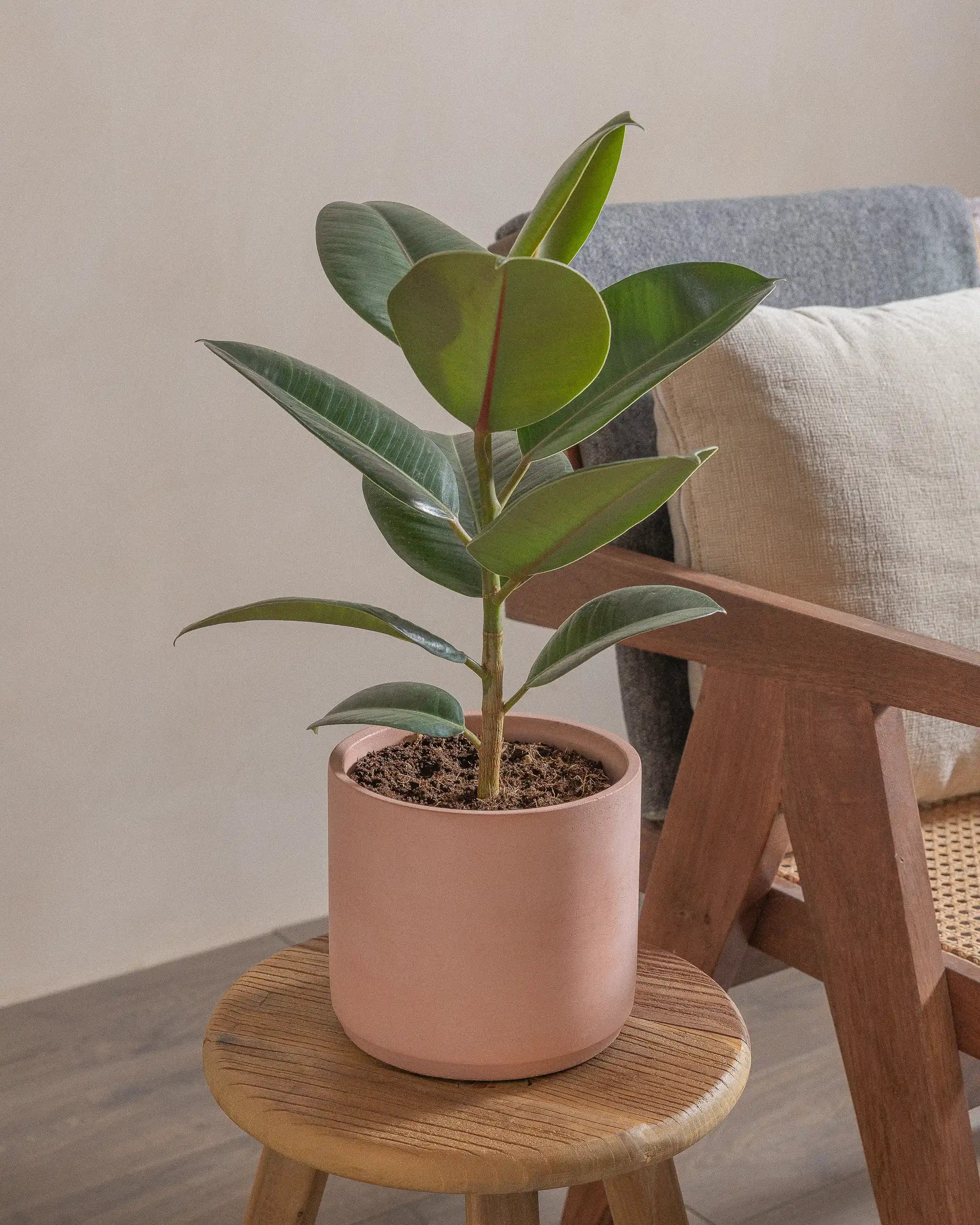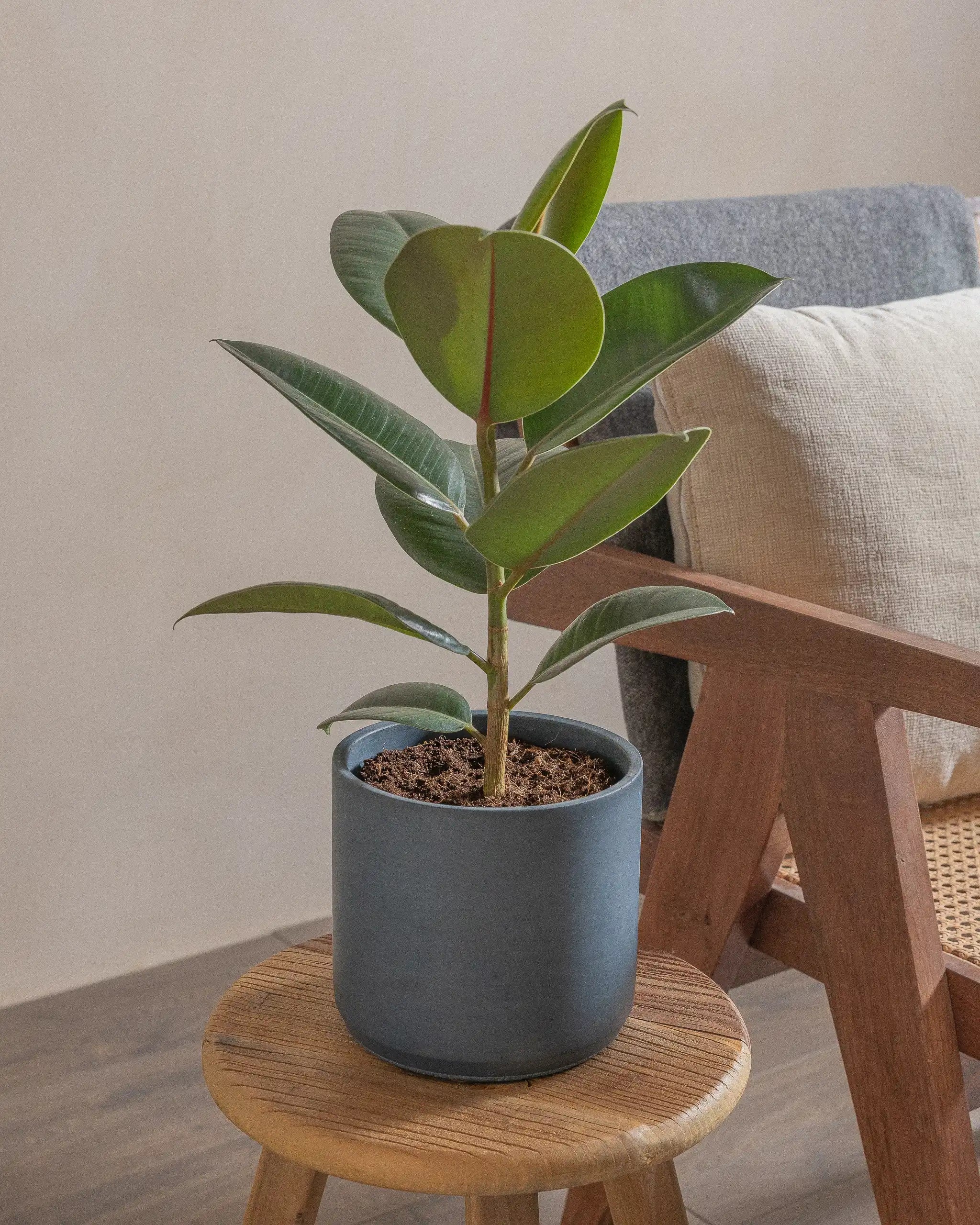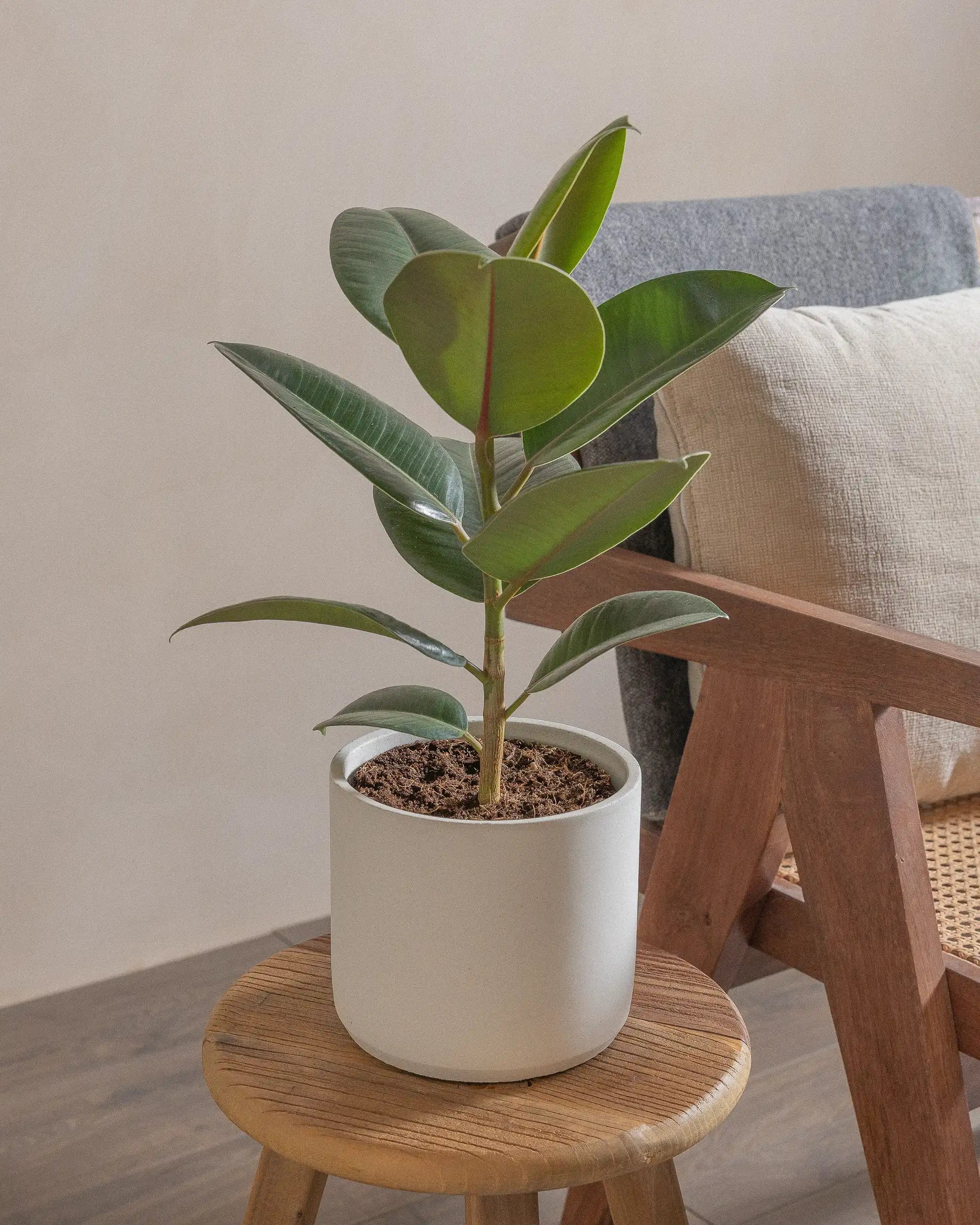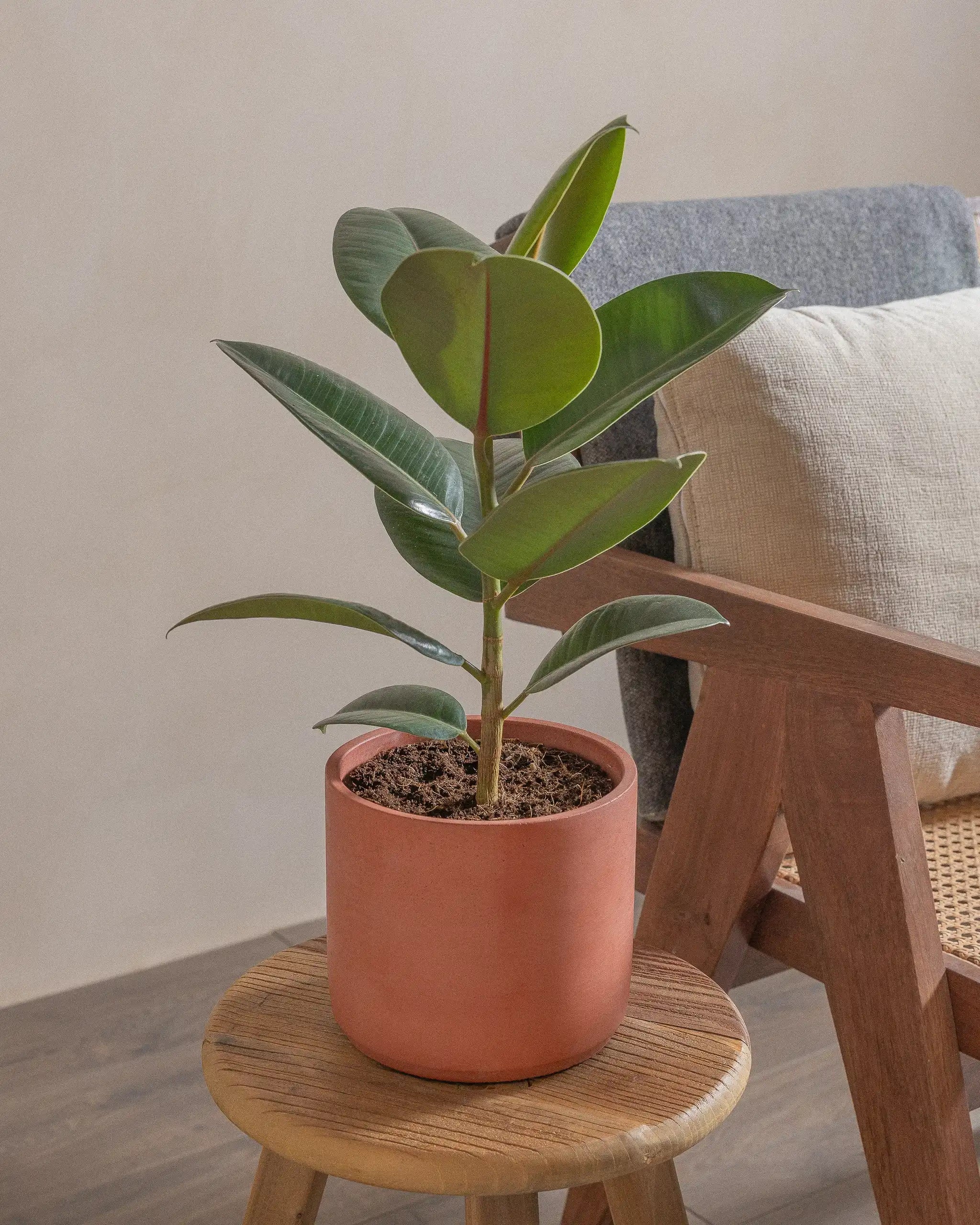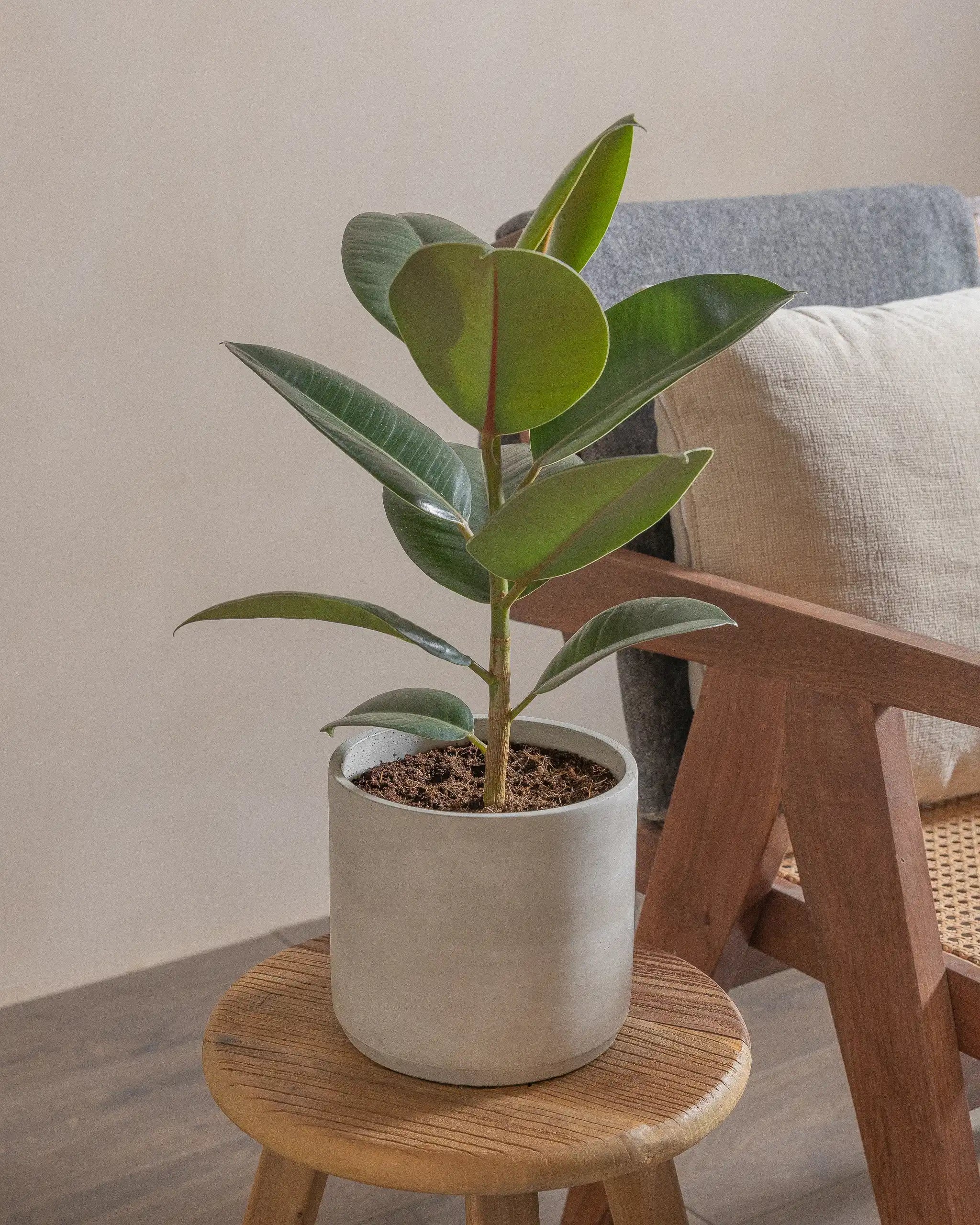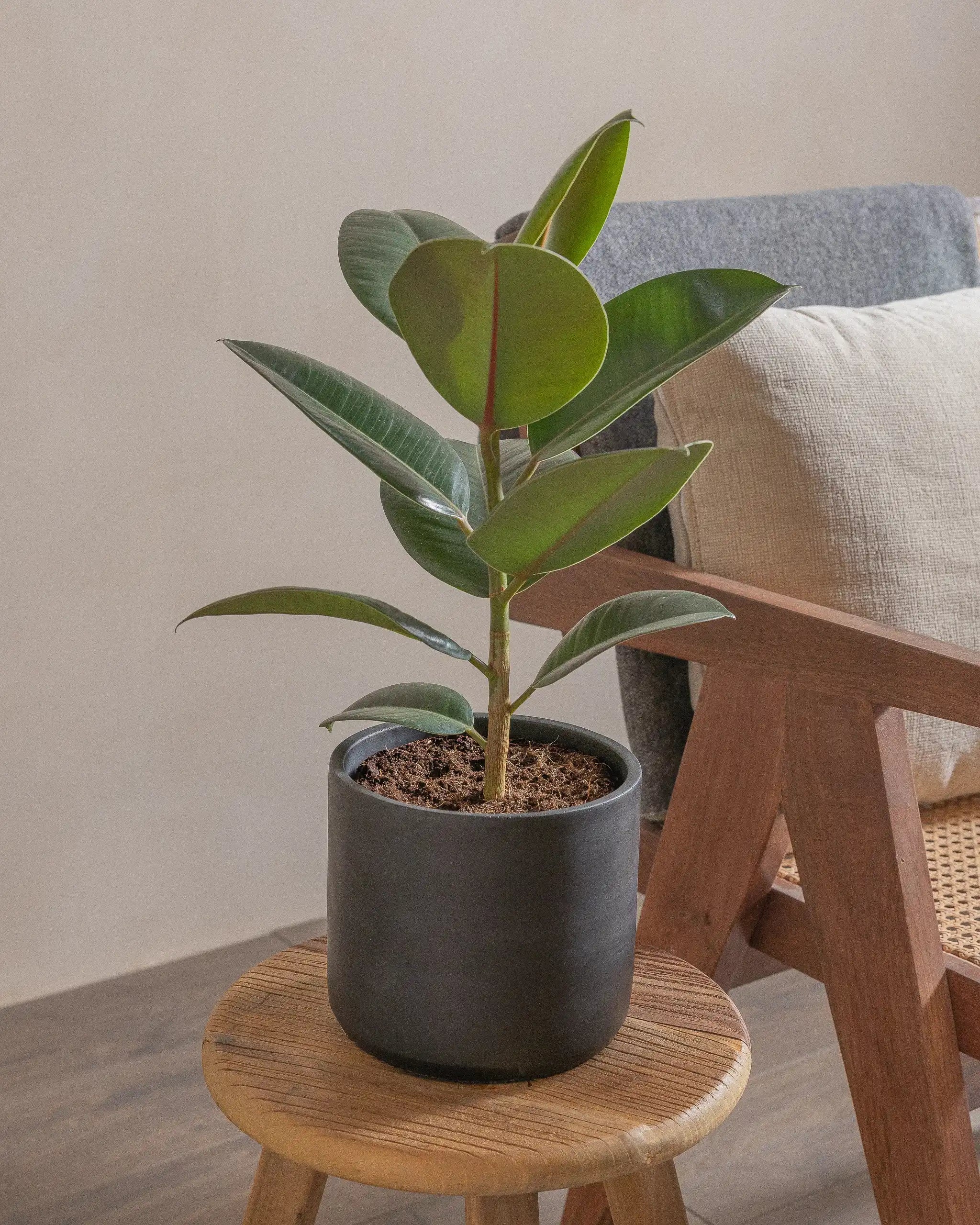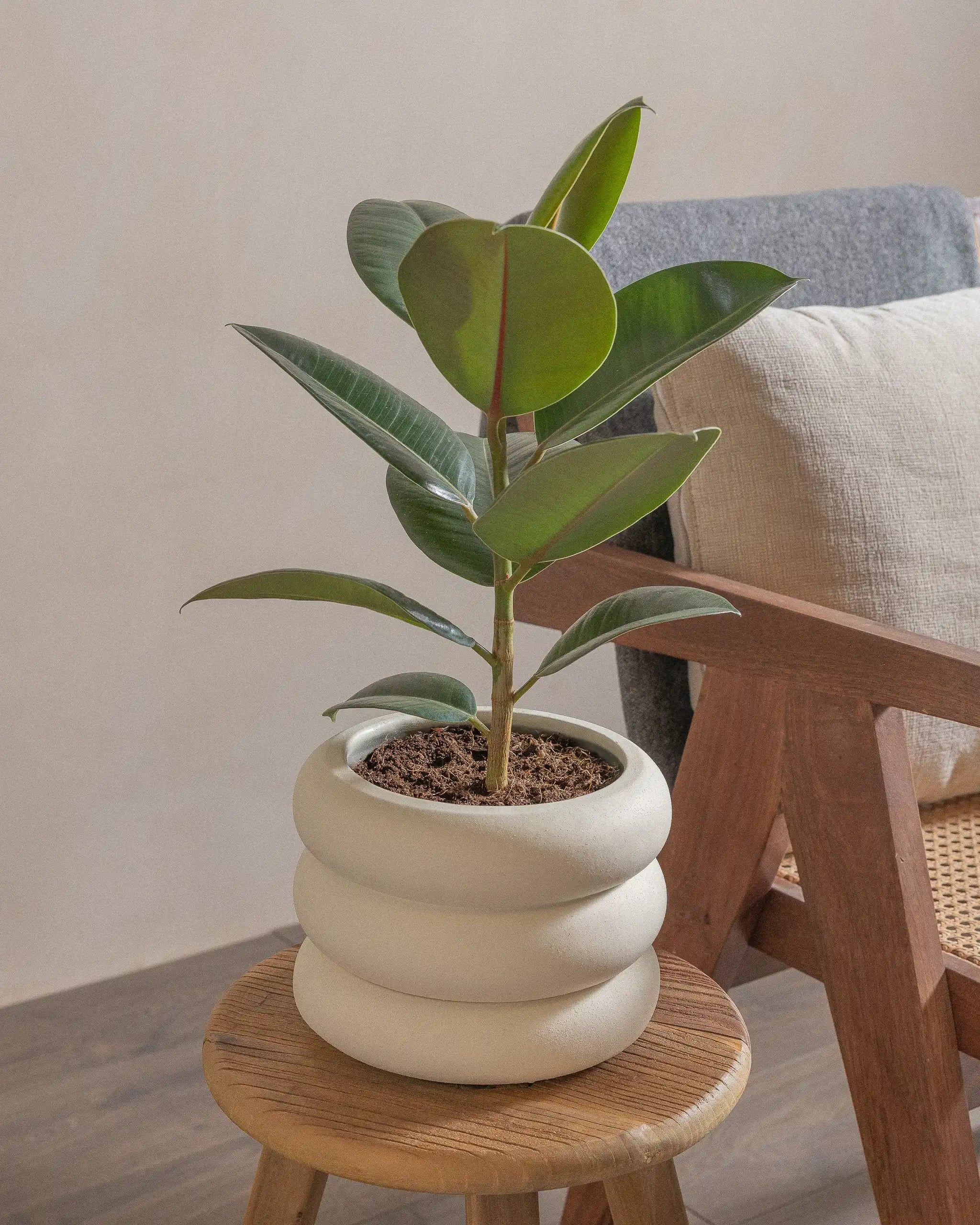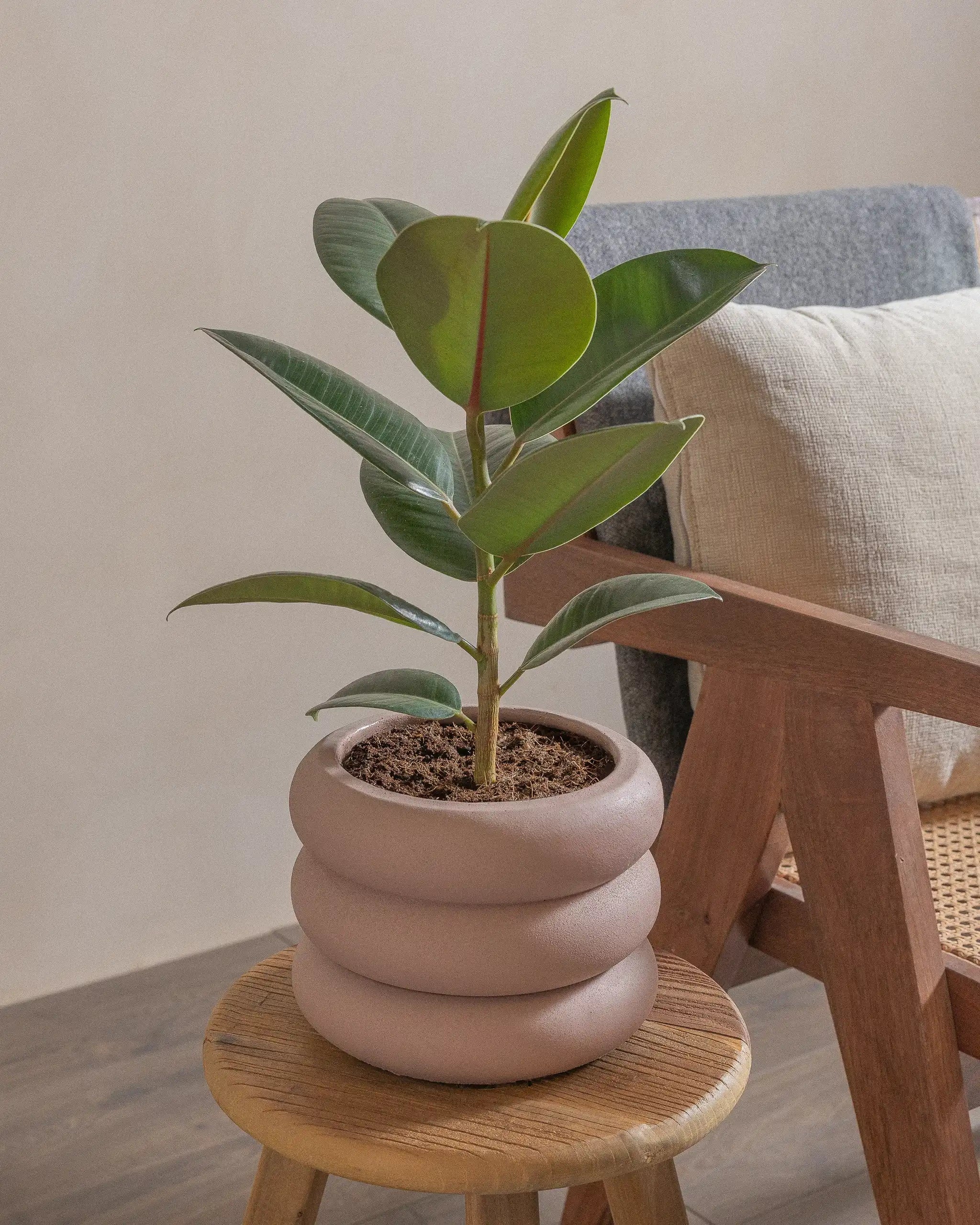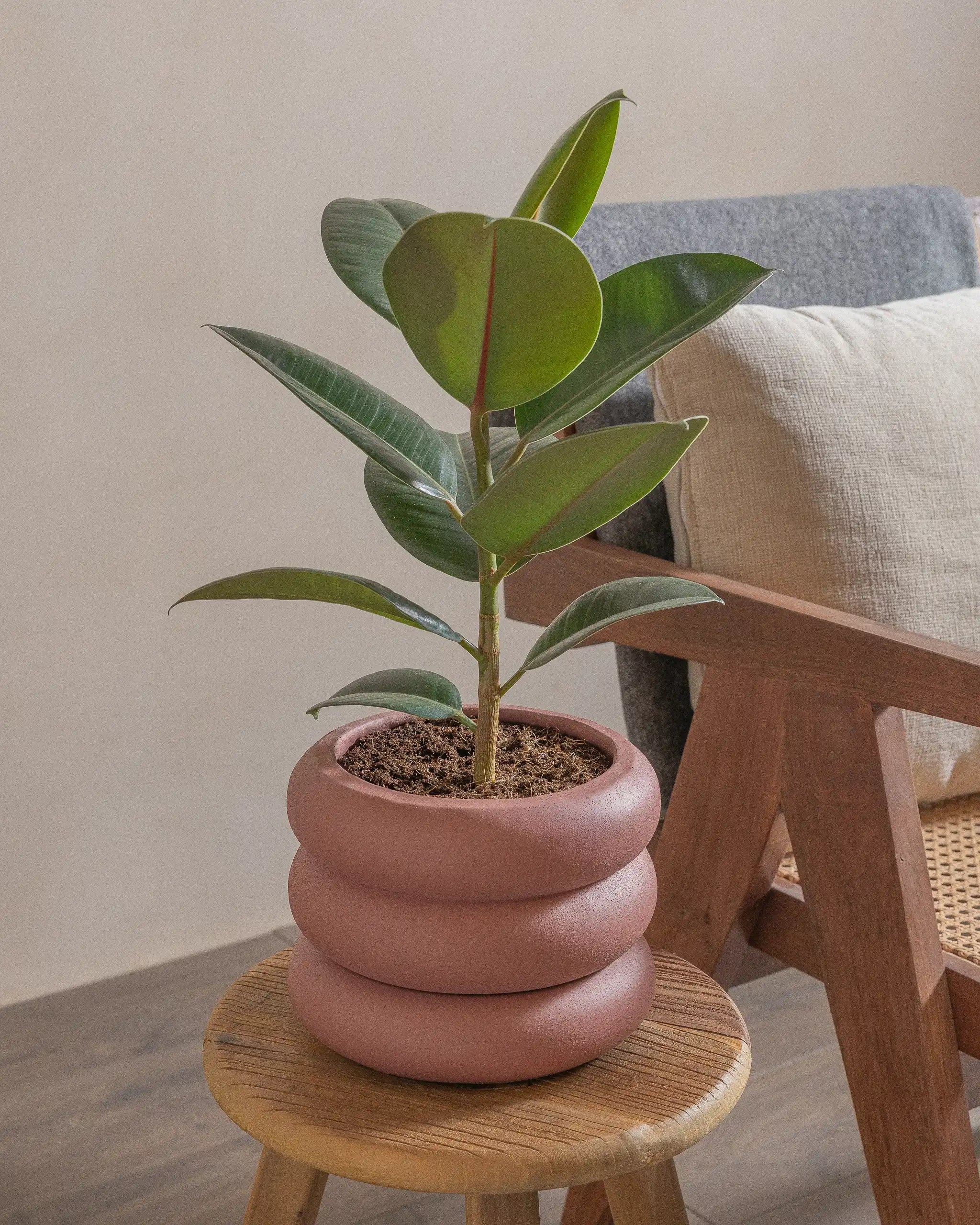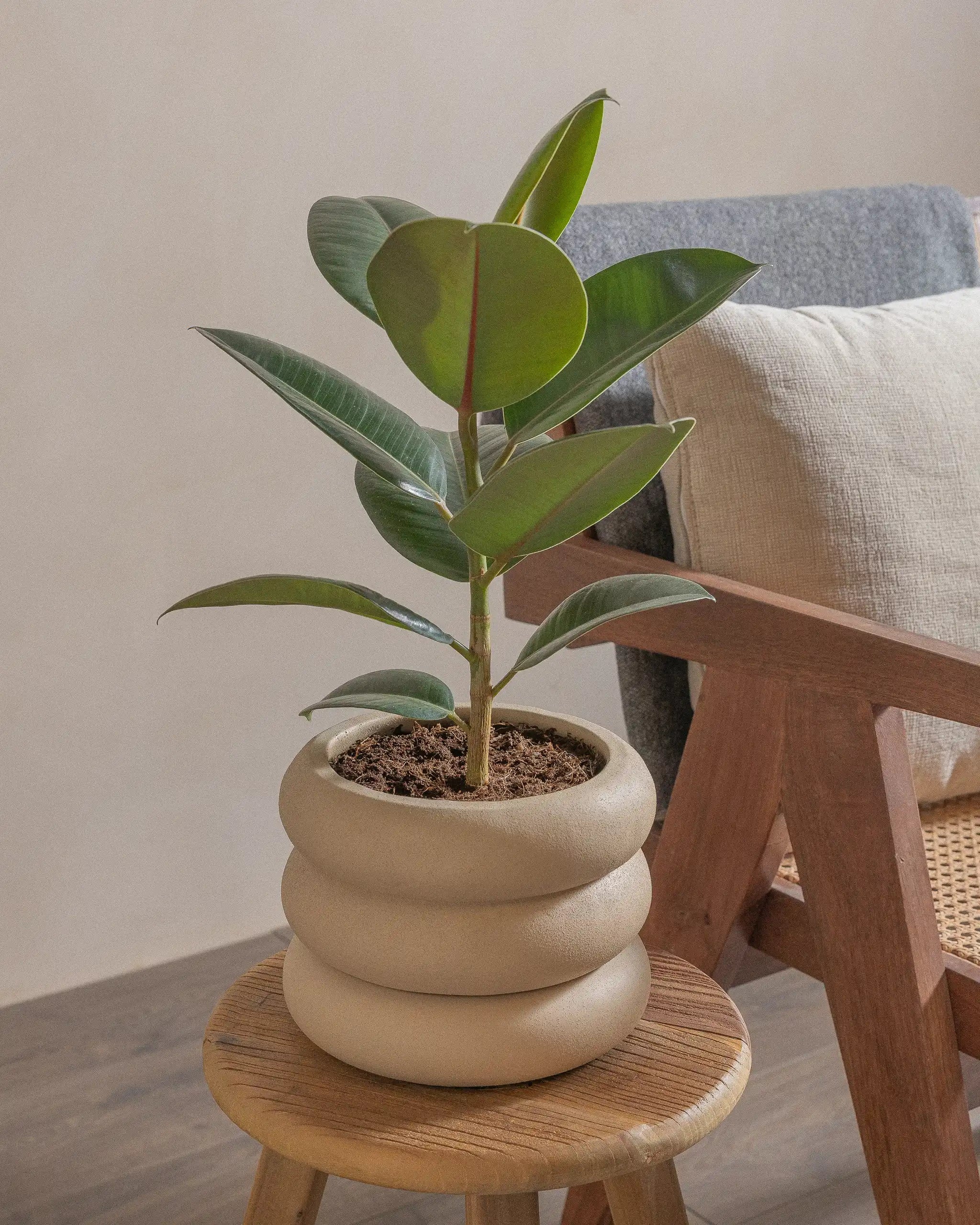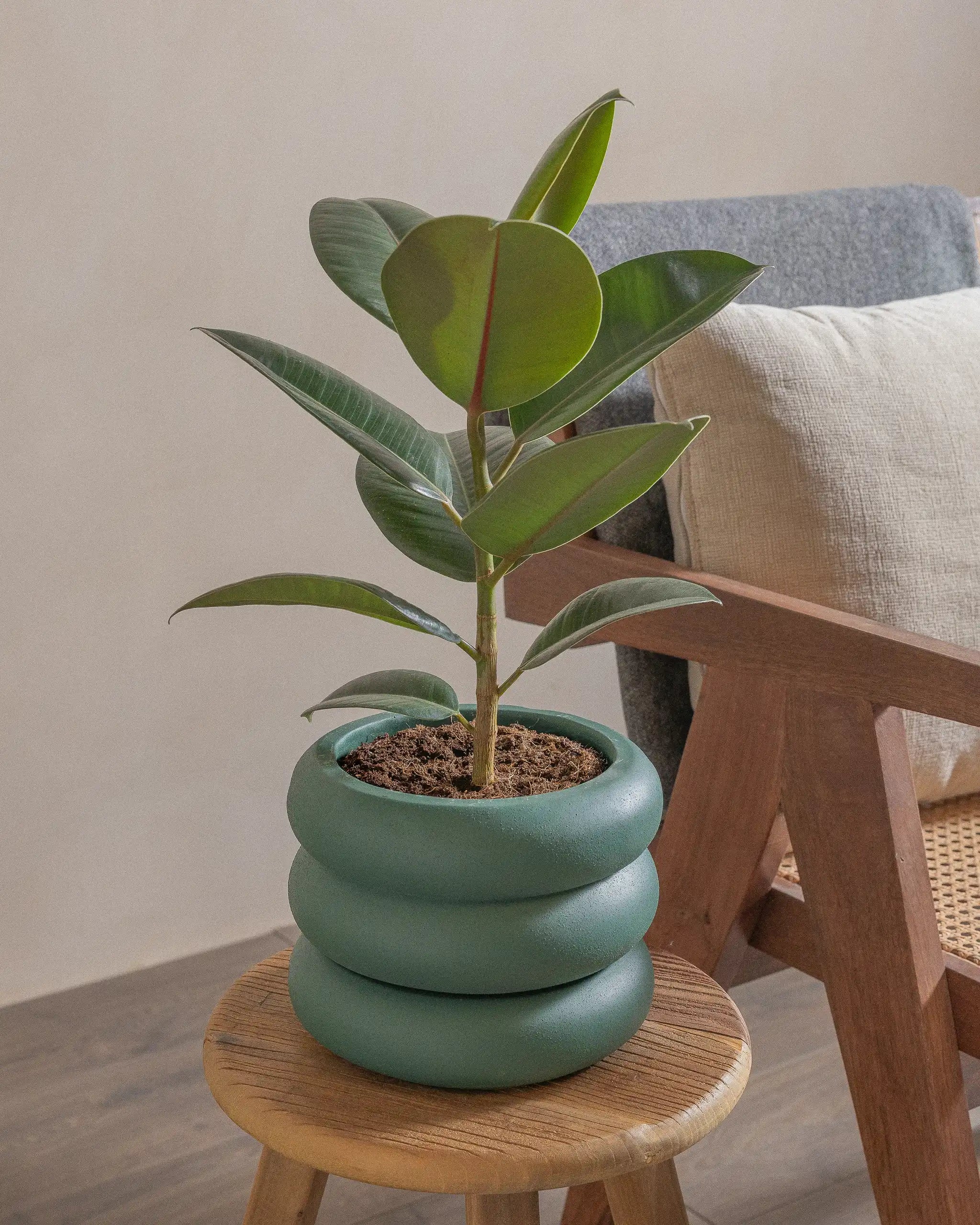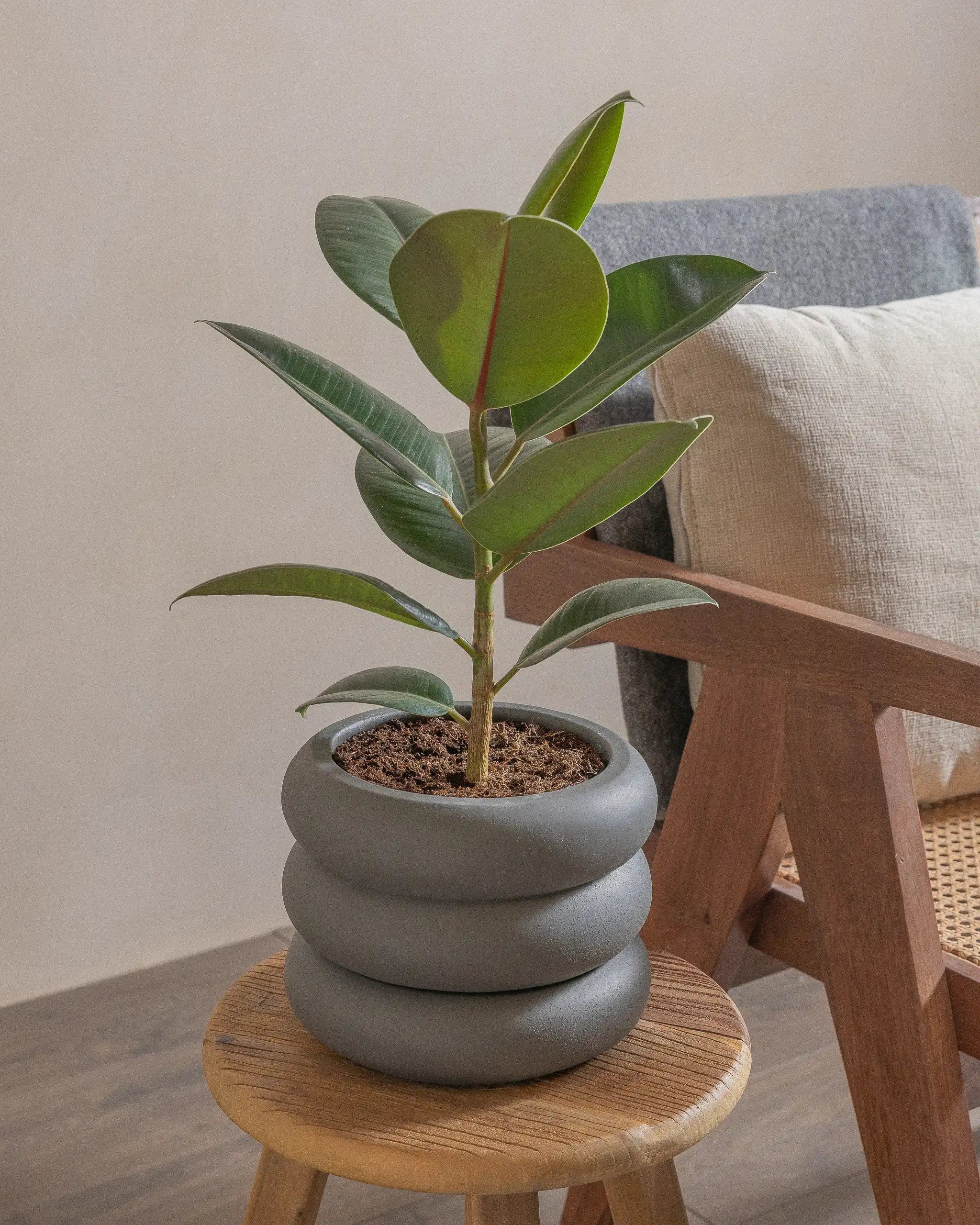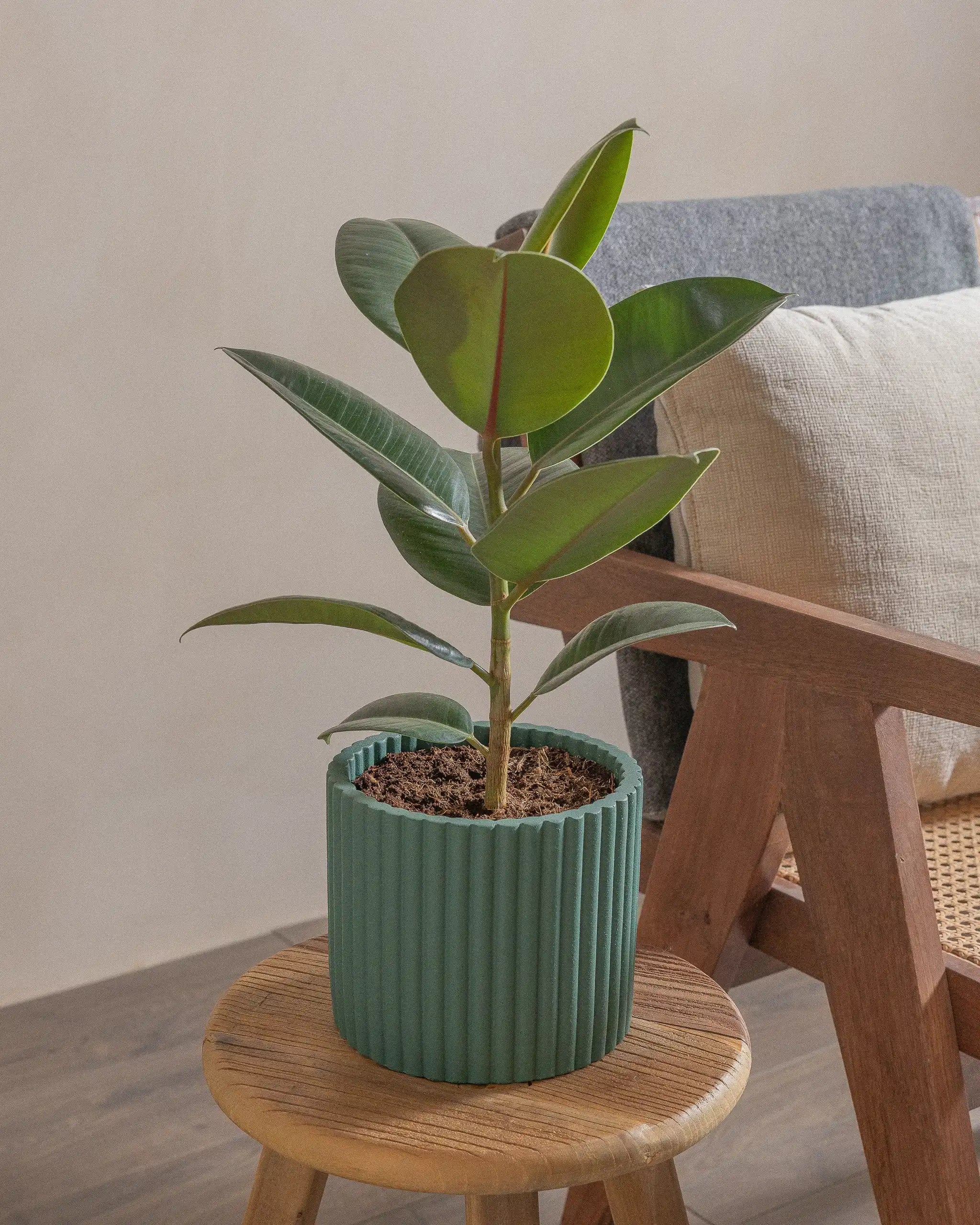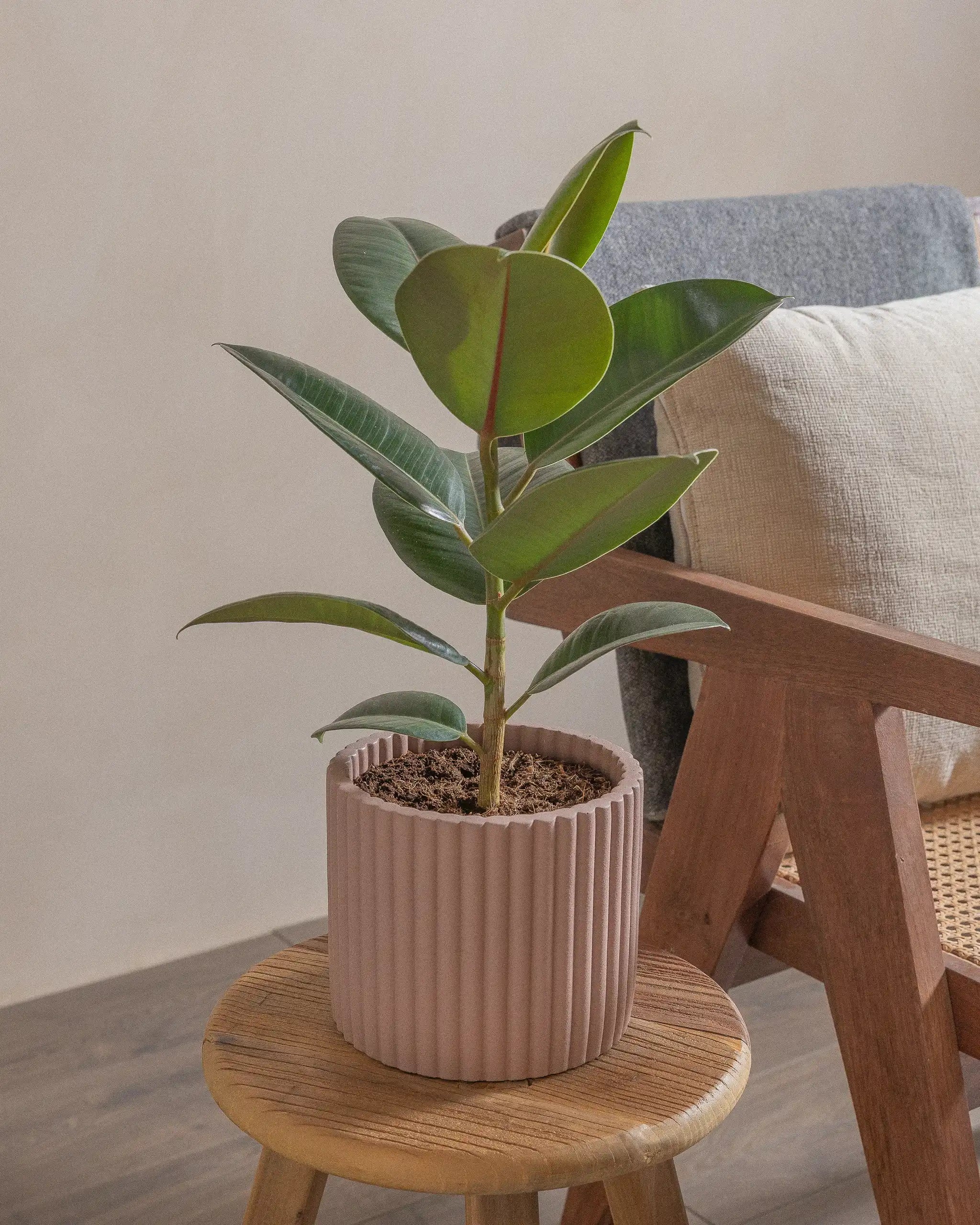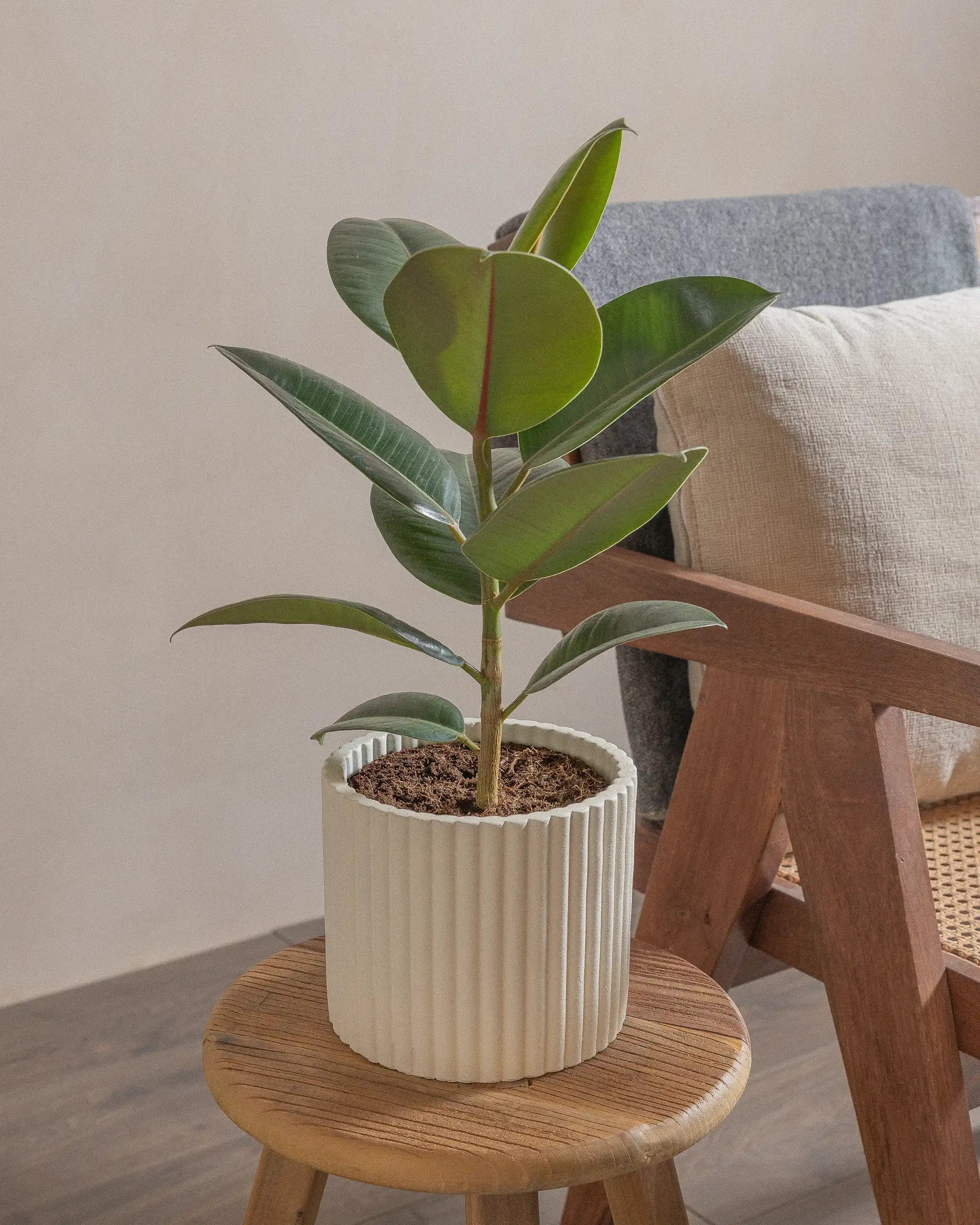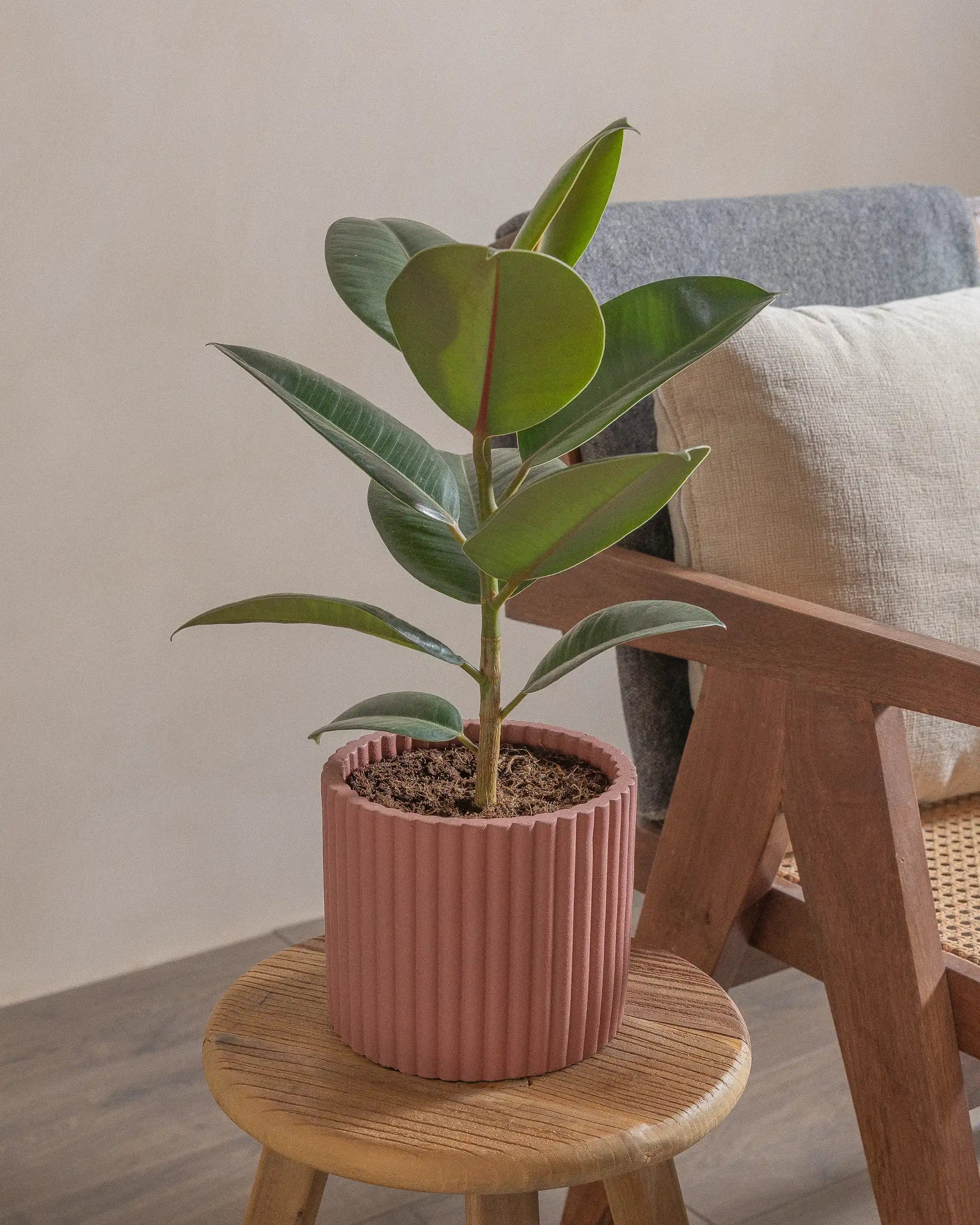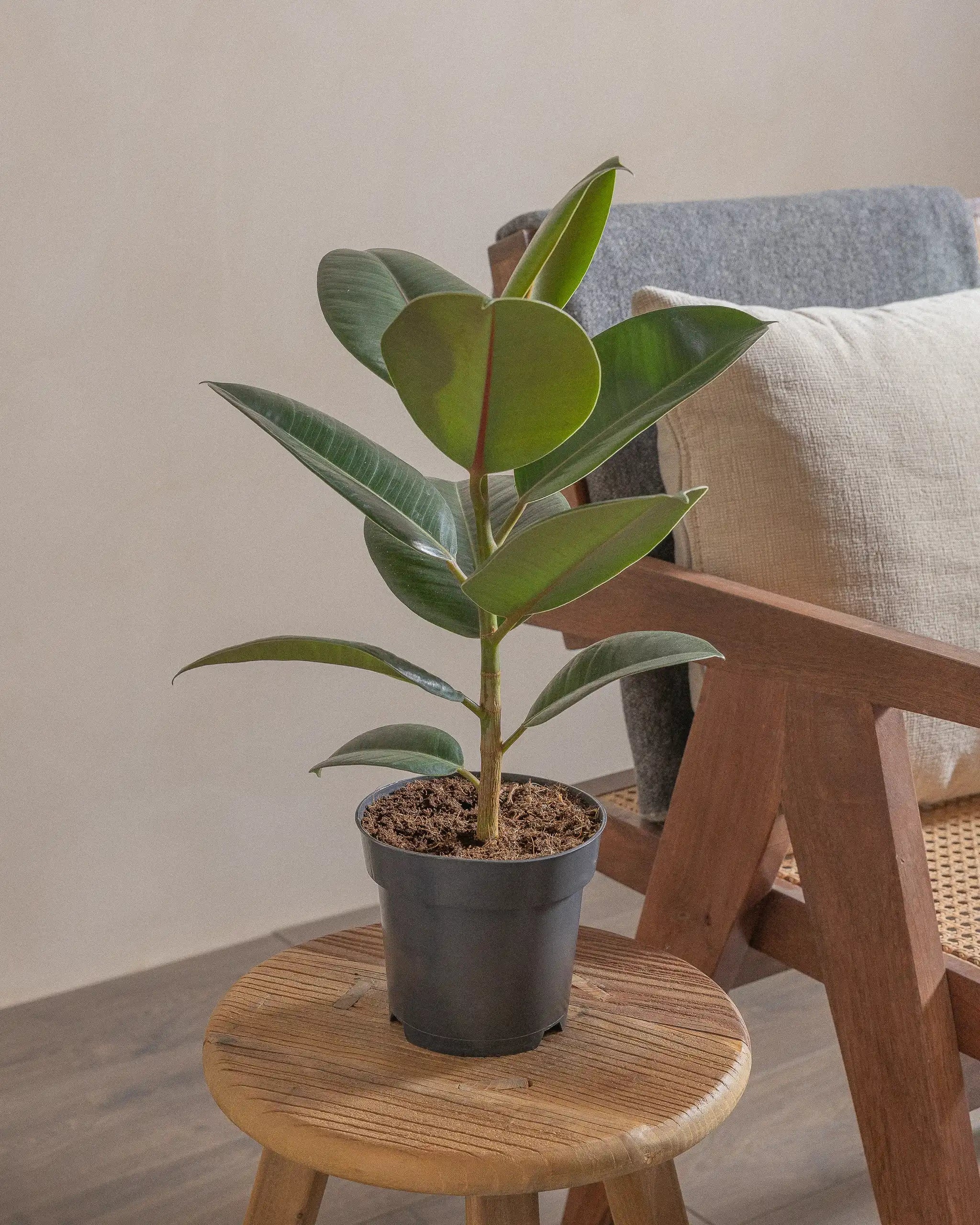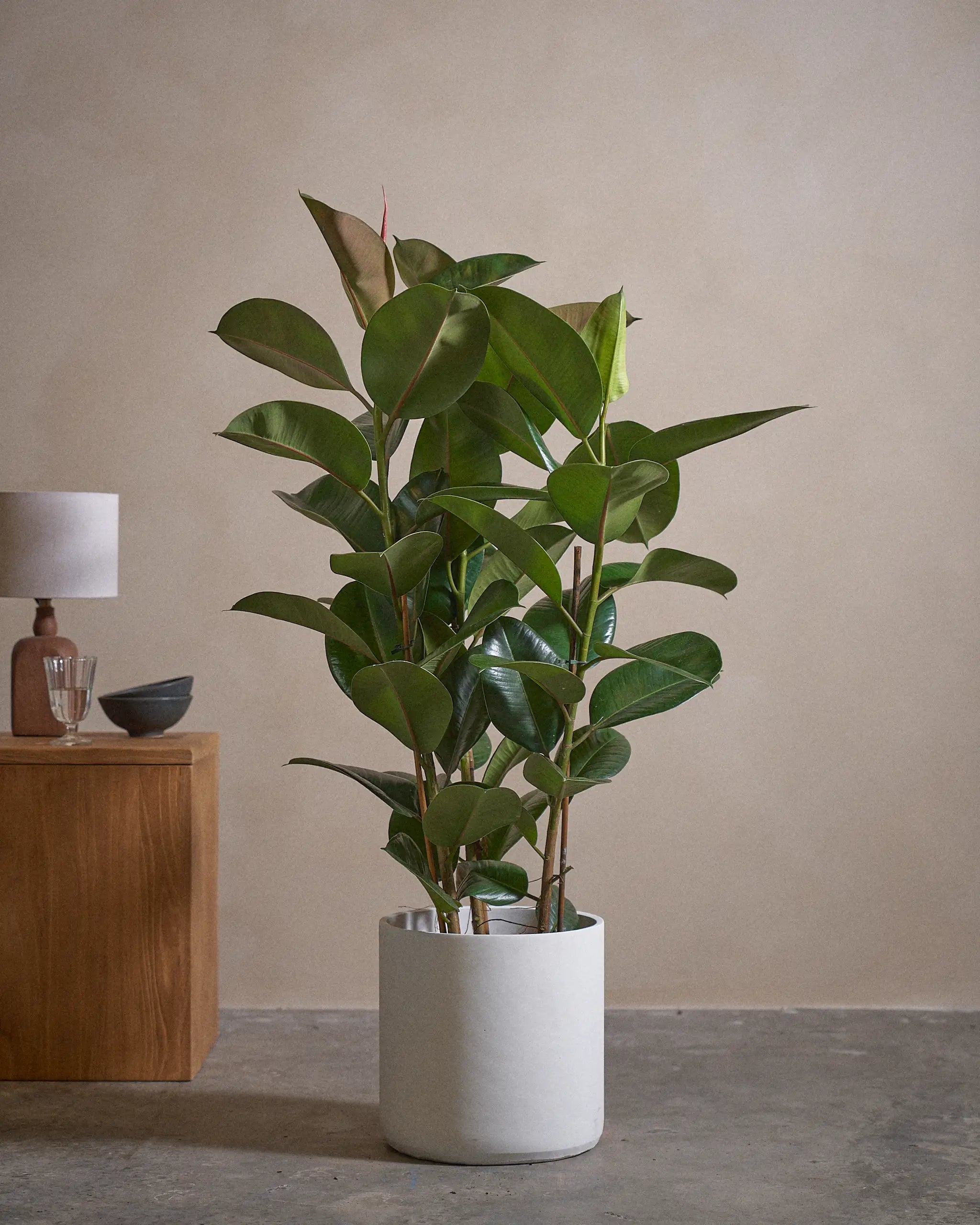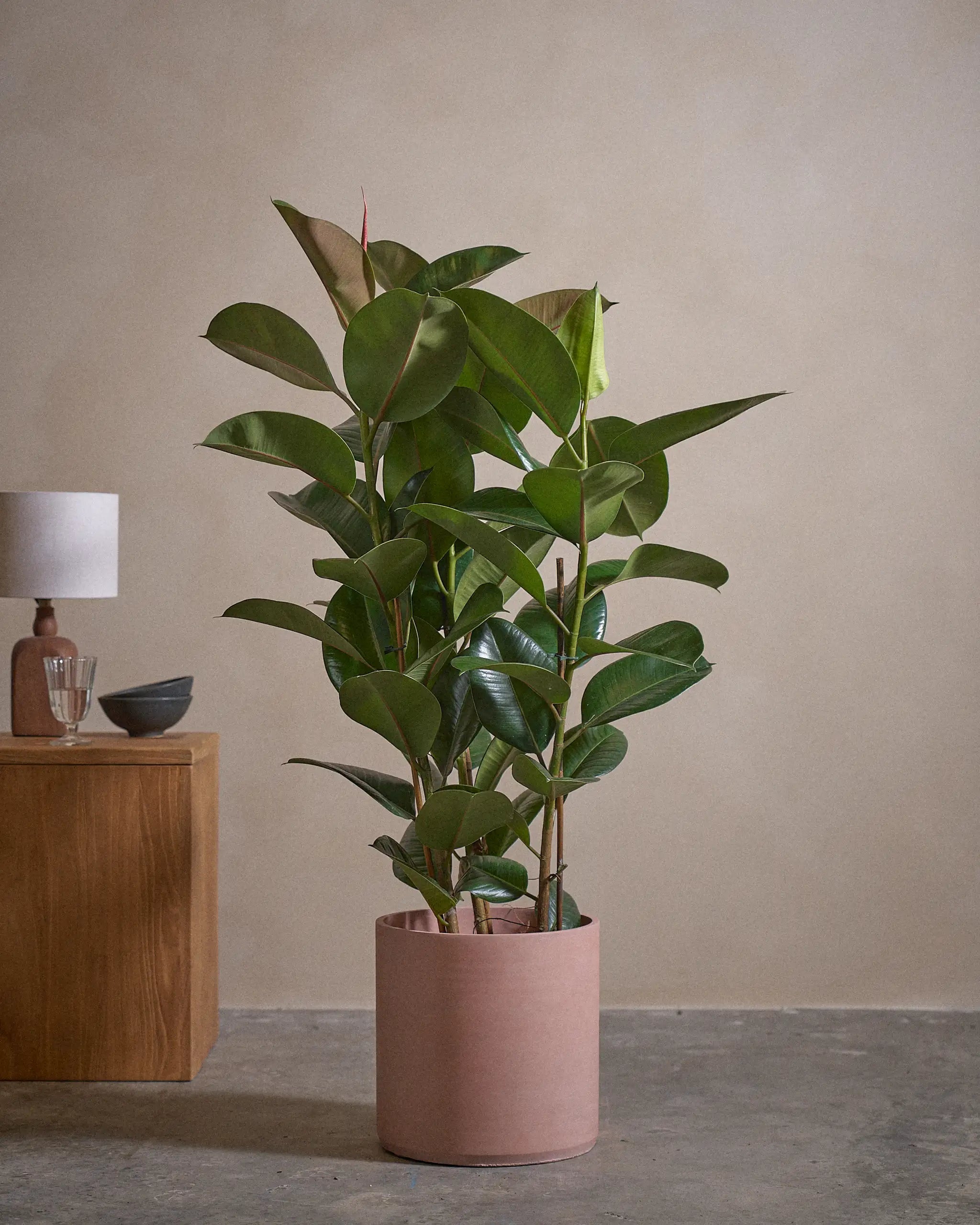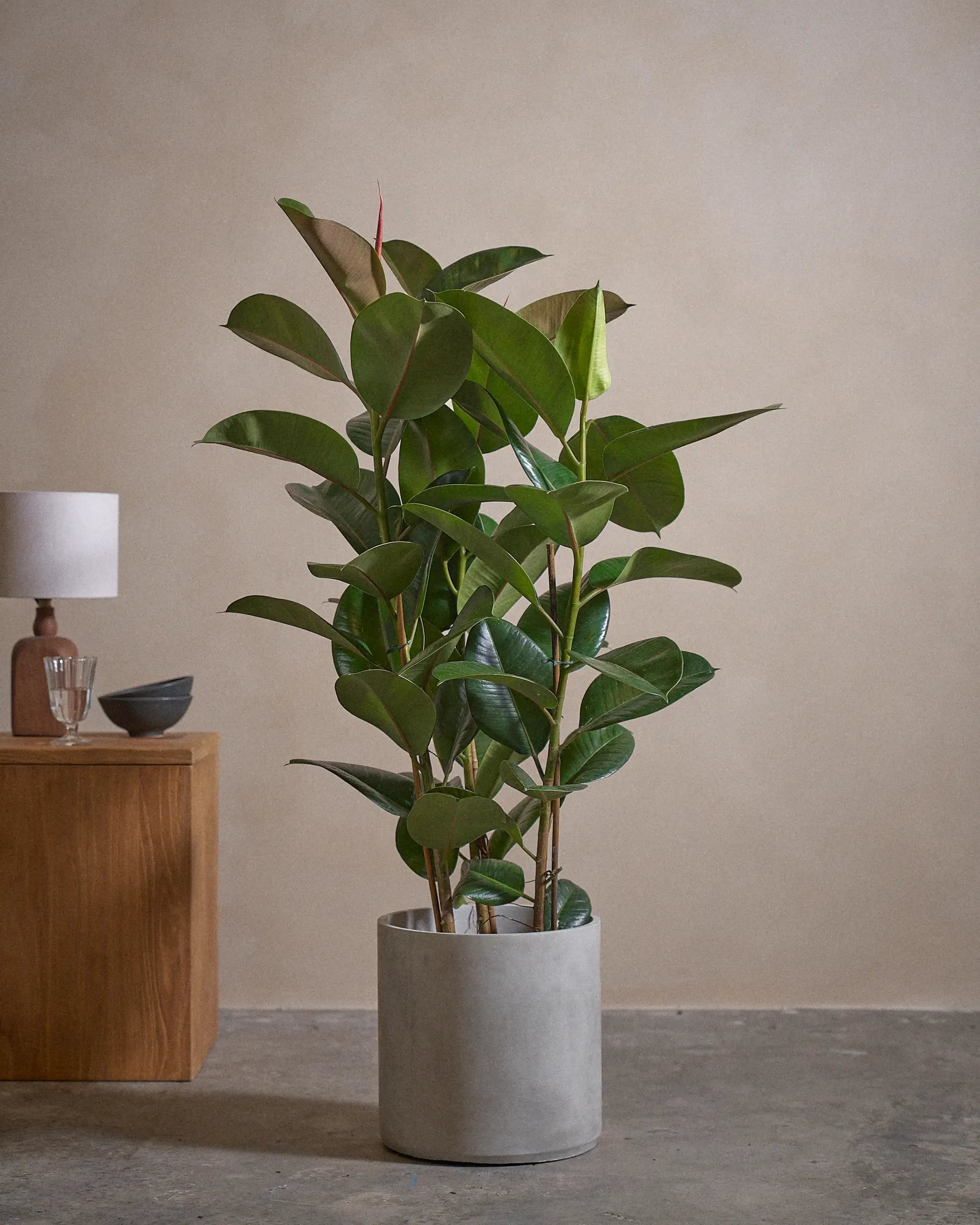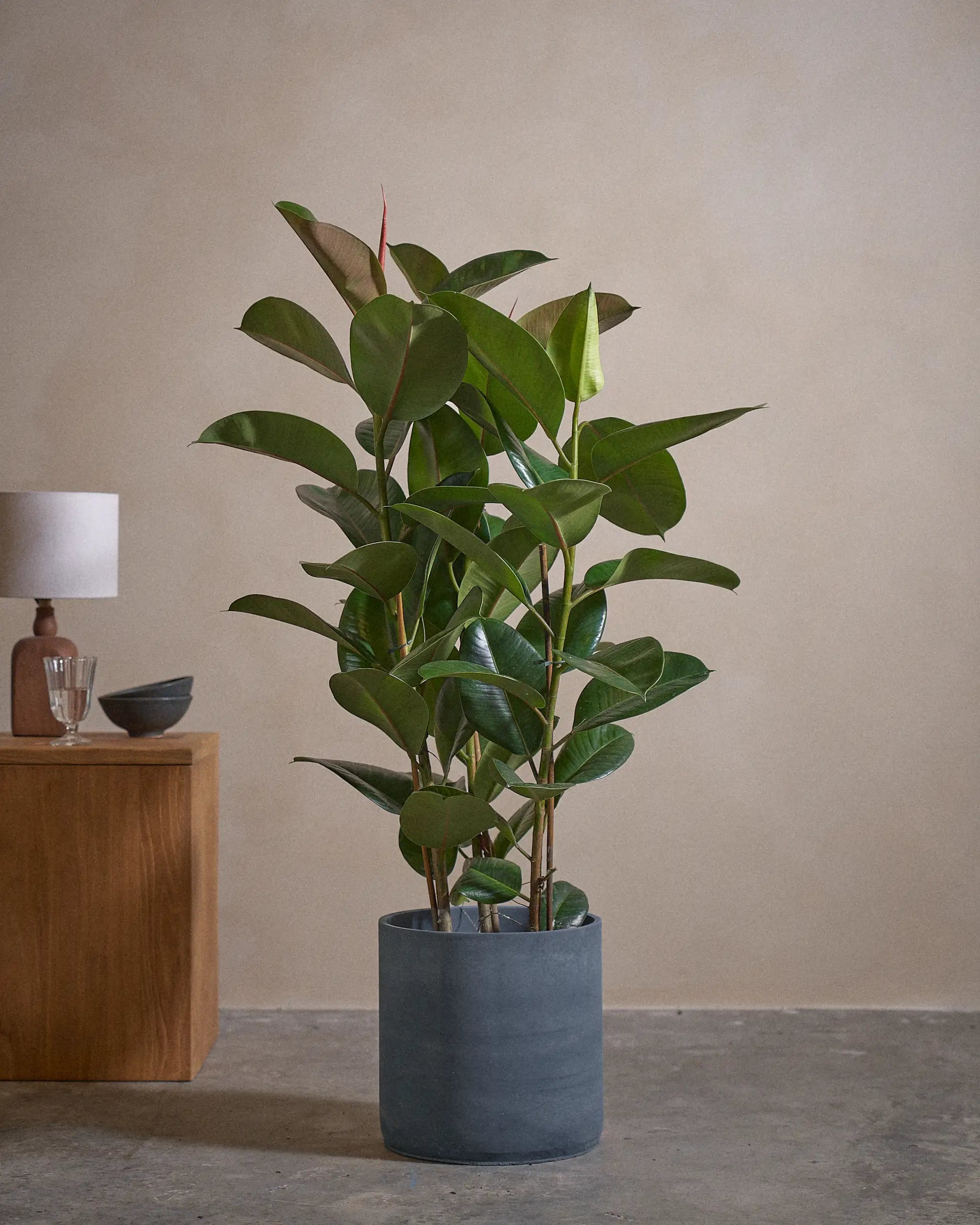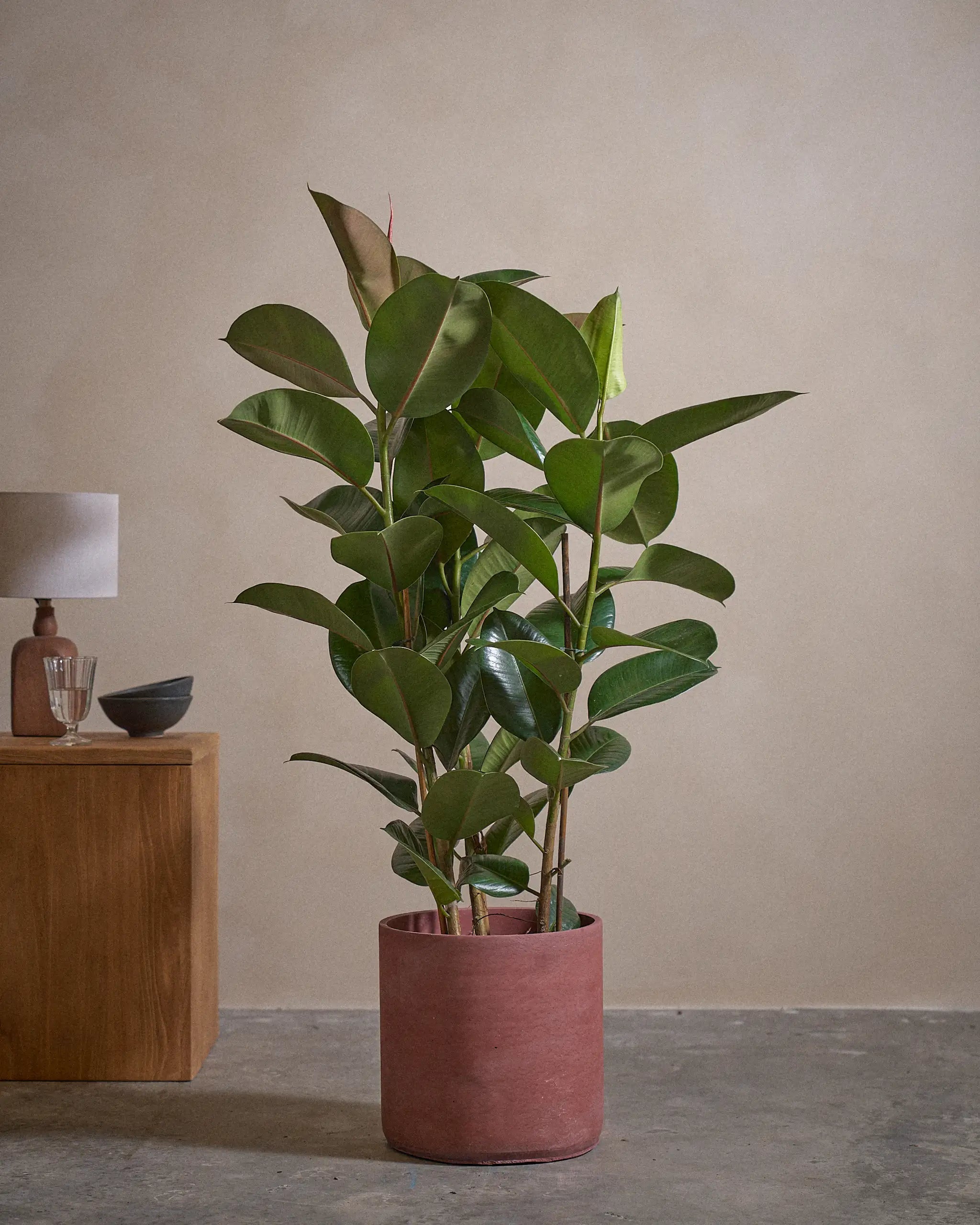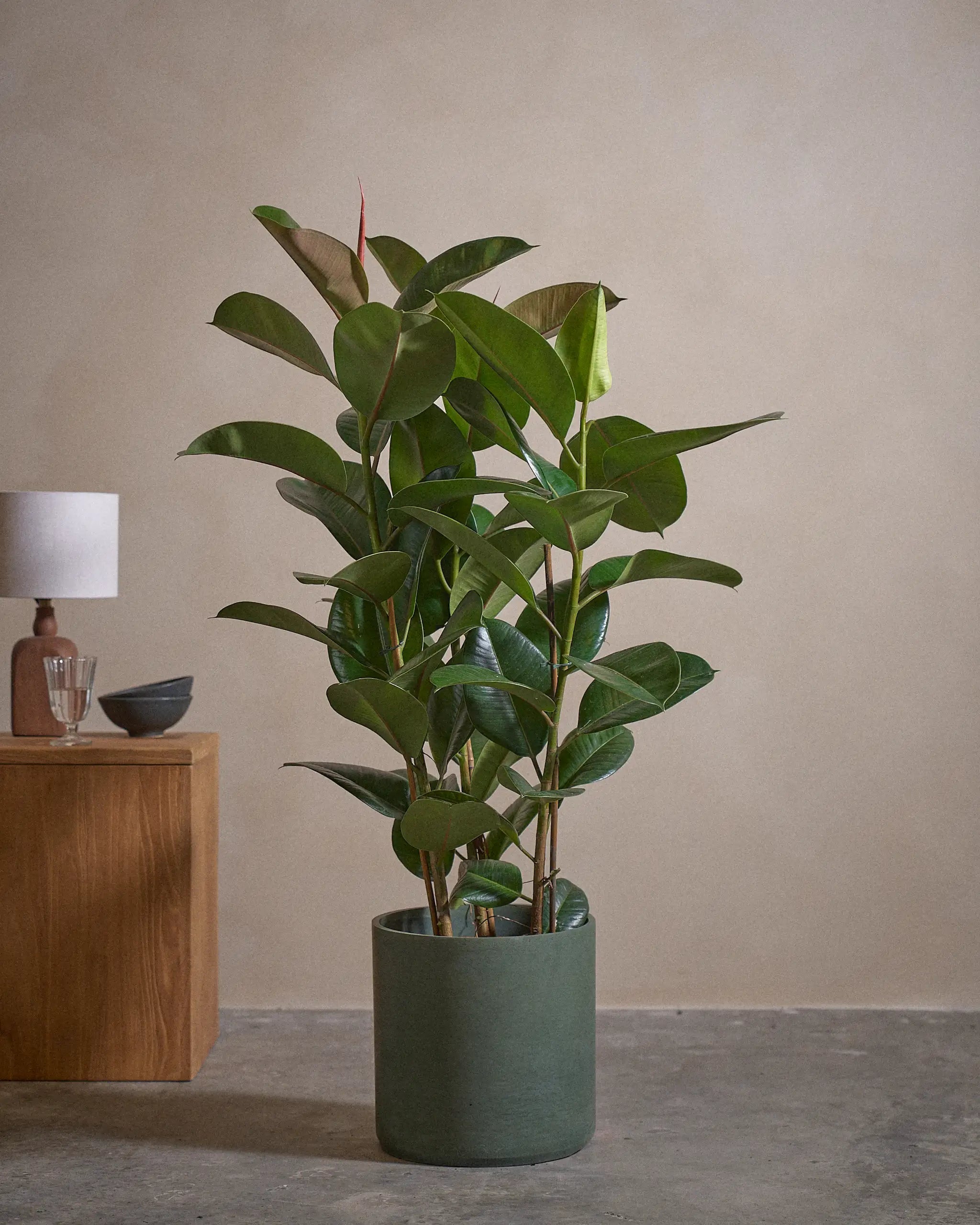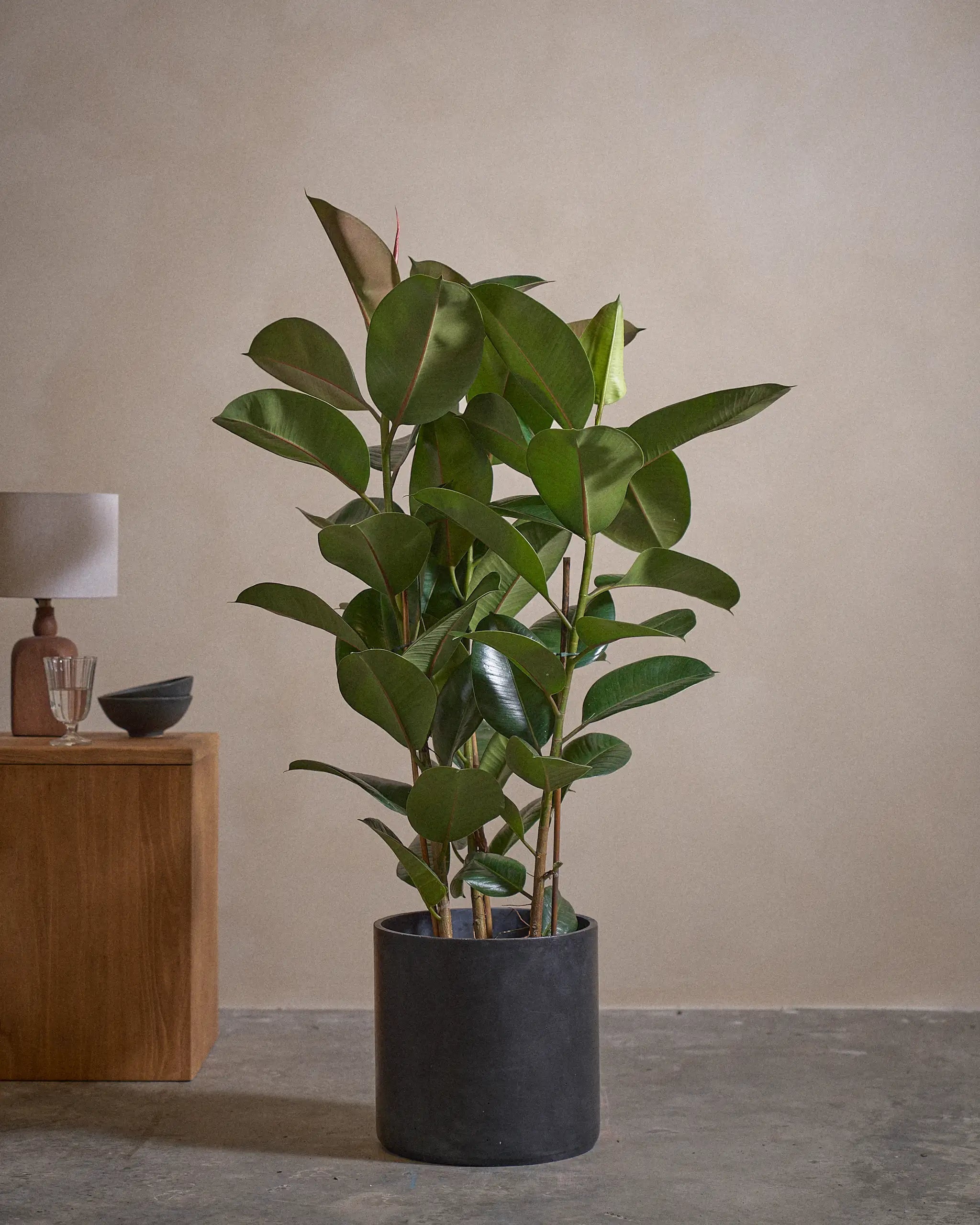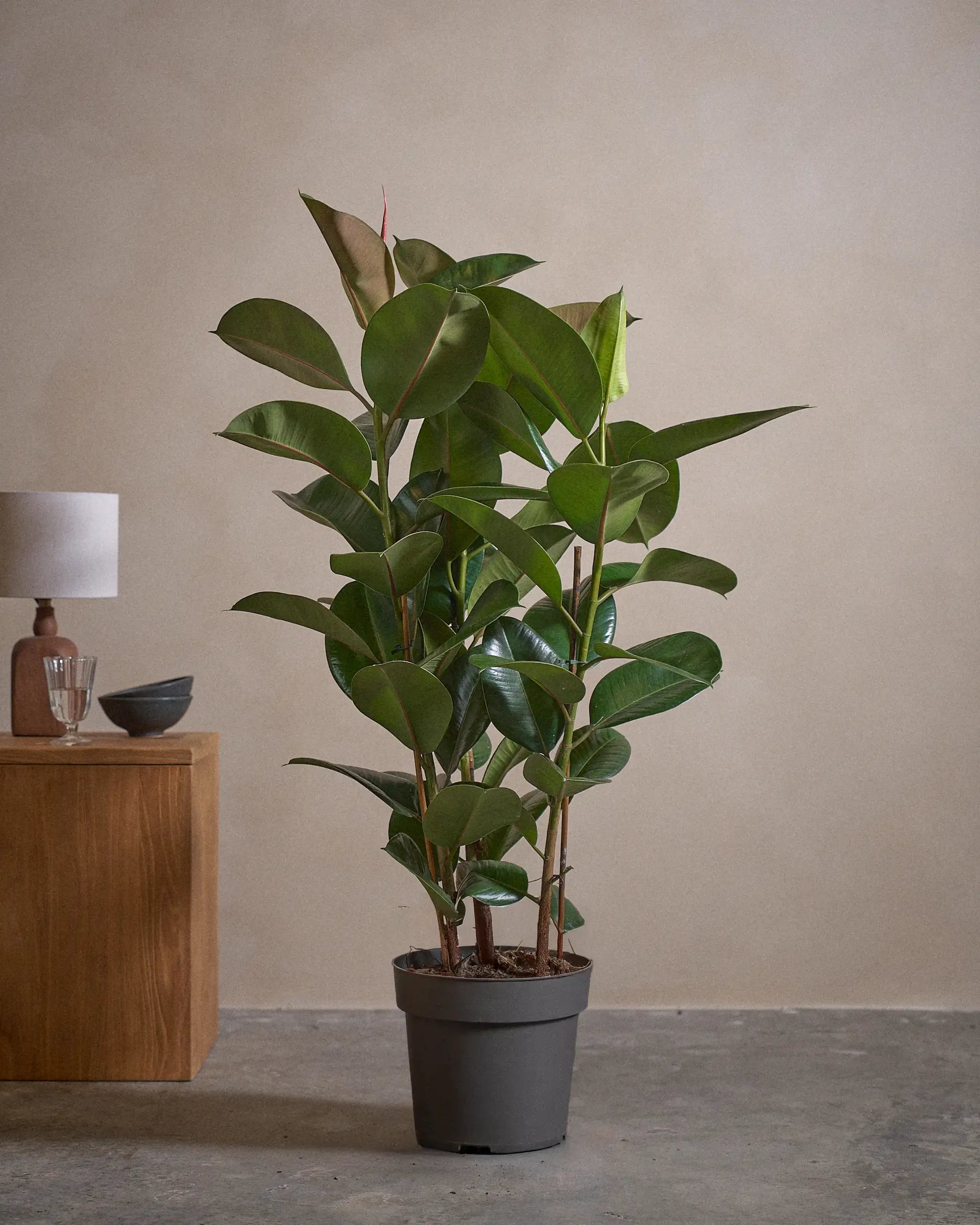How to care for and grow your Rubber Tree
Native to: South to East Asia
Watering needs: Medium (every 1–2 weeks)
Lighting needs: Bright indirect sunlight
Difficulty: Low maintenance
Great for: Plant parents with some experience
Pet-Safe: No
Picking The Right Spot
(Lighting, Air Conditioning, Temperature)
Caring For Your Rubber Tree
(Watering, Dusting, Re-potting)
How do I choose a healthy Rubber Tree?
It's all in the leaves.
It’s Alright If You See:
1. Glossy Leaves: Look for glossy, dark green leaves—the more stunning, the better.
But, Watch Out For:
1. Brown or Yellow Leaves: Unless the yellow leaves are just old leaves aging out, you want to look for healthy, green leaves.
Where do I place my Rubber Tree?
(Lighting, Air Conditioning, Temperature)
Half of plant parenthood is choosing the perfect spot.
Lighting
The more light it gets, the faster and taller your Rubber Plant will grow. However, avoid direct sunlight for more than 4 hrs a day to keep its leaves from scorching or drooping.
Pro-tip: You don’t need to worry about UAE windows, most of them are tinted, so the sunlight coming through is already filtered indirect light, not direct. If you were to keep your Rubber Tree near a non-tinted window, you would see scorch marks on its leaves within the hour.
Air Conditioning
Place your Rubber Tree as far away as possible from the direct air escaping from your AC vent. The dry air may cause its leaf tips to start browning.
Temperature
Like most houseplants, Rubber Trees are happiest between 18 °C – 30 °C.
How do I care for my Rubber Tree
(Watering, Dusting, Re-potting)
How to keep your plant alive (and also show your love).
Watering
Maintain moist soil
Once a week, stick your finger about one inch into the soil. If you feel ANY moisture at all, wait longer before checking again. If the soil feels COMPLETELY DRY, then it’s time to water.
Rubber plants require their entire root ball to be soaked when watering, and use a pot with drainage holes to allow excess water to escape.
Note: The more light it gets, the more often it’ll need to be checked and watered.
Leave water to aerate for 24–48 hours
While Rubber Trees can tolerate tap water, it's best to leave the tap water out overnight to allow the chlorine to evaporate.
Dusting
Once a month, gently wipe away any dust on your plant.
Wiping your Rubber Tree free of dust with a damp rag once a month will help maintain its sheen.
Re-potting
Leave it in its nursery pot
Once you receive your plant, place it in the spot you plan to keep it in (whilst still in its nursery pot) and allow it at least 6 months (ideally 12) to acclimate to your home's temperature and light levels.
Once acclimated, you can choose to either re-pot your plant or leave it in its nursery pot.
Time to re-pot
When it's time, use a high-quality potting mix and transfer your Rubber Tree into a pot that's about 1–2 inches in diameter larger than its current one (or one or two sizes up).
When in doubt, reach out to our team at hello@plntd.ae, and we’ll help you identify whether the soil bag you’re considering will work for your Rubber Tree.
Remember, always go for a pot with drainage holes.
Pro-tip: To keep watering simple and easy, you can simply re-pot your Rubber Tree into a larger nursery pot and place that nursery pot in a larger planter.
Frequently asked questions about Rubber Tree
Ask away, grasshopper.
How easy is a Rubber Tree to care for?
Rubber Trees are low maintenance plants:
- They can tolerate low light levels (though they grow faster the more they get)
- They can tolerate tap water (though it's best to leave the tap water out overnight to allow the chlorine to evaporate)
- They can go 1-2 weeks between drinks (the more light they get, the more you can expect to water them)
Can I use UAE tap water to water my Rubber Tree?
Yes. Rubber Trees can be watered using UAE tap water.
However, to ensure your plant is as healthy as possible, it is best to account for the high level of chlorine and calcium found in UAE tap water (like tap water in most places):
- Leave tap water out for 24–48 hours before using it. This allows the chlorine time to evaporate.
- When watering your Rubber Tree, make sure to water through the soil until it is dripping out the bottom of the nursery pot. This flushes out any excess build-up of calcium (and other minerals) from the soil.
Finally, look out for tell-tale signs of too much chlorine or calcium:
- Scorched brown tips at the leaves = too much chlorine.
- White crystals on the soil = too much calcium.
Will AC harm my Rubber Tree? What temperature should I set it to?
Rubber Plants are tropical plants that thrive in warm, humid climates.
ACs achieve the opposite results: they make the temperature colder, and the air dryer.
The ideal temperature for Rubber Trees, as with most indoor plants, is between 18 °C and 30 °C. Though they can tolerate lower temperatures, you'll need to reduce your watering drastically, as the risk of overwatering increases the lower the temperature is.
So, whenever possible, place your Rubber Tree (this applies to all plants) as far away from AC vents as possible.
To combat the drying effect of the AC, mist your Rubber Tree with water to replicate its native climate. Once a week is minimum; once a day is ideal!
Do I have to re-pot my Rubber Tree as soon as I receive it?
In short, no.
Once you receive your plant, place it in the spot you plan to keep it in (whilst still in its nursery pot) and allow it at least 6 months (ideally 12) to acclimate to your home's temperature and light levels.
Once acclimated, you can choose to either re-pot your plant or leave it in its nursery pot.
Some Common Problems
What are its leaves telling you?
Brown Leaves
If yellow leaves on Rubber Trees are not taken care of, they will turn brown. Check out the causes and suggestions for yellow leaves if that was the case with your Rubber Tree.
Below are causes for leaves turning brown without usually turning yellow first.
Cause 1: Dry environment
Suggestion: Consider increasing the humidity around your plant by misting daily. Alternatively, you can use the pebble-tray method.
Cause 2: Temperature
Suggestion: Like most houseplants, Rubber Trees are happiest between 18 °C – 30 °C. Anything warmer or cooler will lead to browning. If this is the case with your plant, move it somewhere that matches its preferred temperature range.
Curling Leaves
Cause 1: Underwatering
Suggestion: Time for a drink!
Cause 2: Dry environment
Suggestion: Consider misting your plant daily using a mister. Alternatively, you can use the pebble-tray method.
Cause 3: Pest infestation
Suggestion: Rubber Trees are quite pest-resistant, but if you do come across pests then we recommend hosing your plant daily for 4-6 weeks, or using a neem oil or soapy water. Use insecticide only as a last resort.
Drooping Leaves
Cause: Underwatering
Suggestion: Time for a drink!
Leaves Falling Off
Cause 1: New environment
Suggestion: Your rubber tree will lose a few leaves when it is placed in a new environment. Just give it time to acclimate and don’t worry for now.
Cause 2: Old age
Suggestion: Your rubber tree will naturally drop older leaves to make room for newer ones so it's nothing to worry about.
Cause 3: Dry climate
Suggestion: If your plant is placed next to an AC vent, try moving it to an area with less dry air flow.
Cause 4: Not enough light
Suggestion: If your plant is placed in the shade, try moving it closer to the window, remembering to avoid direct sunlight.
Wilting Leaves
Cause: Watering issue
Suggestion: Step back to look at your current watering schedule and observe its soil and roots for waterlogging or root rot. Increase or decrease your current watering frequency as needed.
Cause: Soil issue
Suggestion: You may need to get soil more suited for your Rubber Tree.
Yellow Leaves
Cause 1: Watering issue
Suggestion: Step back to look at your current watering schedule and observe its soil and roots for waterlogging or root rot. Increase or decrease your current watering frequency as needed.
Cause 2: Not enough sunlight
Suggestion: Move your plant to a place with more indirect sunlight, but not outdoors or under direct sunlight.
Cause 3: Natural life cycle
Suggestion: Your leaves reaching old age is an impressive feat! Good job! You can snip them off if you want, so that the plant conserves energy for its newer leaves.
Cause 4: Pests
Suggestion: Rubber Trees are quite pest-resistant, but if you do come across pests then we recommend hosing your plant daily for 4-6 weeks, or using a neem oil or soapy water. Use insecticide only as a last resort.
Buying Rubber Trees Online
When shopping for a plant online, look out for the following:
Height
If you're looking for a table-top plant, then go for one that's 40cm tall. A 60cm tall plant would work well on a low side-table. Plants about 1 meter or taller would work well as statement floor plants.
Note: Stated heights will always include the height of the plant AND planter.
Pot style
This is all about the vibe you're looking for, and you'll typically have a choice amongst different colors and shapes.
If you're looking for subtlety, we suggest a circular pot in white. To make more of a statement, look for contrasting shapes and colors!
Delivery
It goes without saying that your plant supplier should meticulously package all plants.
When you personally buy a plant from a store, you're able to rush it home, ensuring it stays outside for as little time as possible. But when you order online, your plant will ride-share with a lot of other plants all on their way to their new homes.
Depending on where you live, weather can play a big part in your plant's health along the way.
If possible, ask your plant shop what precautions they take to ensure your plants stay as safe as possible en route to you.
Reviews
Reading customer reviews is a good way to get an idea of the customer experience provided by the seller (here's ours, by the way), but you need to practice caution there.
Don't expect to be able to tell a fake review right away, some reviewers can be great con artists, and some negative reviews can be fake to harm the seller.
Your best bet is to zoom out and look at multiple comments from multiple categories to get a good overview of whether you can trust this company and/or their review section.
For example, look at how recent the reviews are, and how spread apart. Was there a sudden spike of comments in a short amount of time? Do they sound like they're all written by someone rehashing the same template? Do they all sound too positive to be real?
Yes, going all detective on reviews can be a chore, but Future You will thank you for it.
Returns and refund policies
Things can go wrong.
Sometimes it's no one's fault, and sometimes there's nothing anyone can do.
So the best practice is to offer (and honor) a no-questions asked return/refund policy. Check out the seller's policy before you make a purchase, so you know you're insured in case things don't work out.
You can check out our return/refund policy here.
Ready to adopt a Rubber Tree?
Your Rubber Tree can't wait to meet you — just choose a height and pot and let's introduce you two!
Tough? Check. Large, thick, glossy leaves? Yep. Resilient to brief changes in temperature? You bet. This plant's hardiness makes it perfectly suited for a spot by the entrance of your home, setting the tone for anybody who comes to visit.

